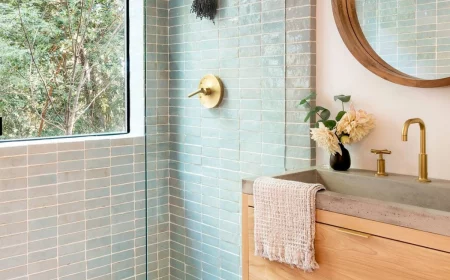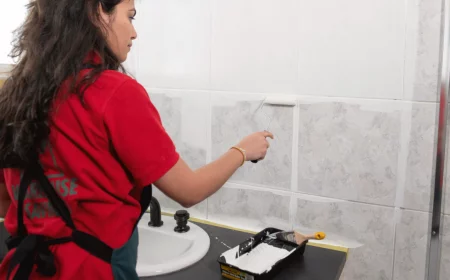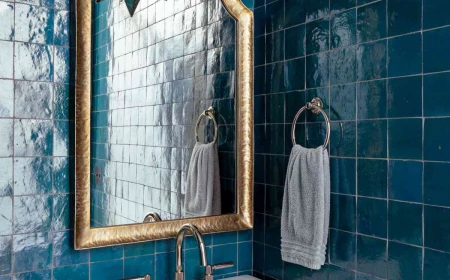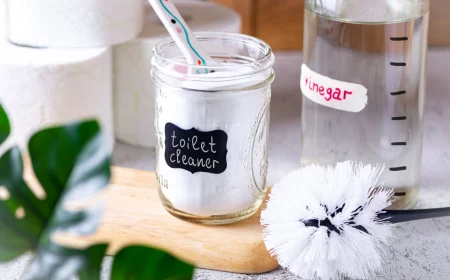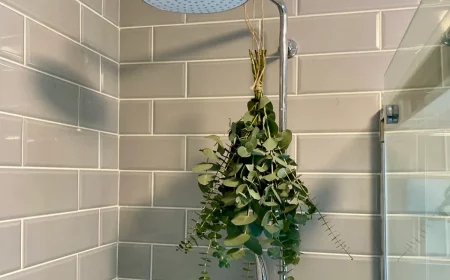How to Build a Farmhouse Bathroom That Actually Lasts (And What It’ll Cost You)
I’ve been renovating homes for over two decades, getting my hands dirty on everything from historic houses to new builds trying to capture that classic, cozy spirit. And I’ve learned something crucial: the modern farmhouse style people are after isn’t just a look. It’s a feeling. It’s about honest materials and a space built for real life, not just for a photo.
In this article
It’s not about buying a sign that says “gather” and calling it a day. It’s about making choices that will stand up to slammed toilet seats, steamy showers, and muddy boots. The kind of durability the old farmhouses were famous for.
So when someone asks for a farmhouse bathroom, I know what they’re really asking for is warmth, simplicity, and a space that feels grounded. The tricky part? A bathroom has to be waterproof, practical, and easy to clean. One wrong material choice doesn’t just look off; it can lead to rot, mold, and repairs that cost a fortune. I’ve been the guy they call to fix it, and it’s never pretty.
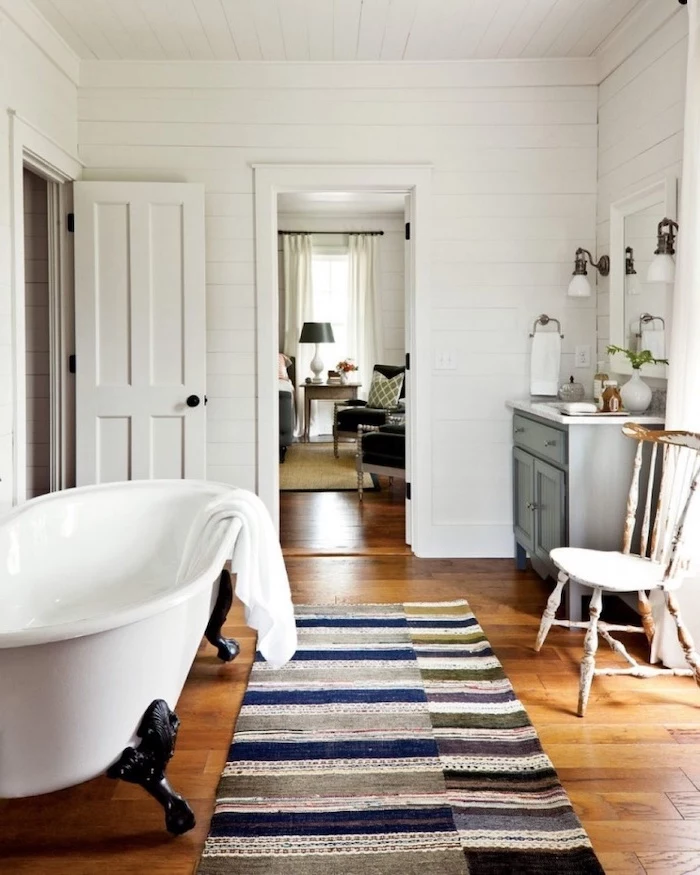
This guide isn’t about decorations. It’s my collection of field notes—the materials that work, the methods the pros use, and the common mistakes you absolutely need to avoid. My goal is to help you build a bathroom that not only looks incredible but will last for decades.
The Foundation: Walls and Floors That Do the Hard Work
Before you even dream about a trough sink or a vintage-style rug, you have to get the bones of the room right. Your walls and floors are the first line of defense against water. This is where you absolutely cannot cut corners.
Let’s Talk Shiplap (The Real Deal and Its Lookalikes)
Shiplap is probably the number one request I get for this style. But there’s a ton of confusion out there. Real, traditional shiplap boards have a special overlapping joint called a rabbet, which creates a tight seal. That’s why it was originally used on the outside of barns.
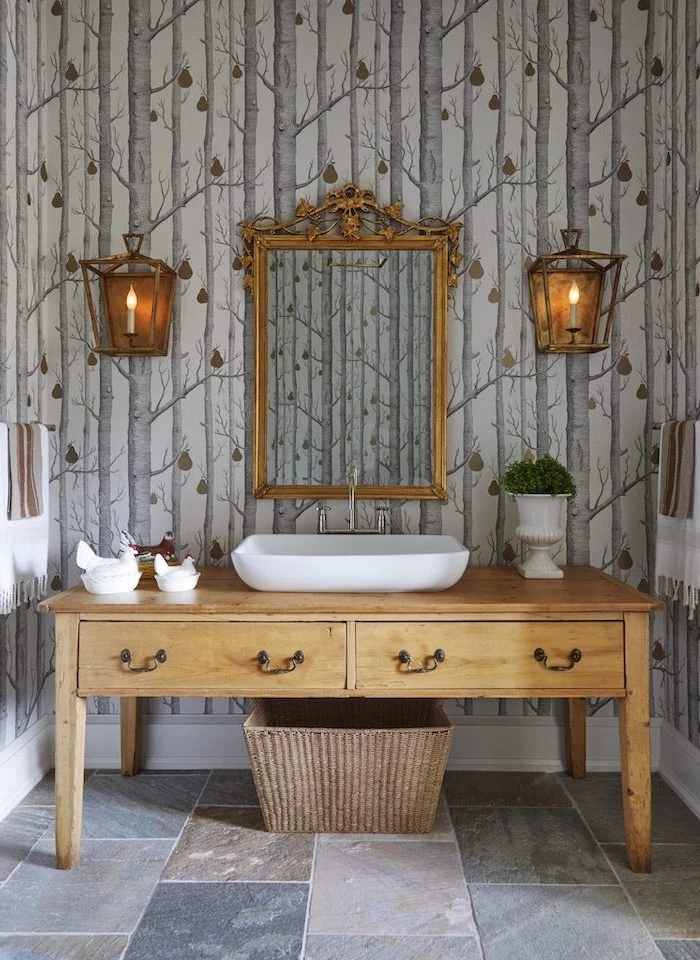
Bringing it into a high-moisture zone like a bathroom means you have to be smart.
- Real Wood Shiplap: This gives you the most authentic vibe. Cedar is fantastic because it’s naturally resistant to moisture, but it’s pricier. Pine is more common and budget-friendly. A quick tip: you MUST seal every single board on all six sides—front, back, and all four edges—before it even thinks about touching your wall. We use a quality primer and two topcoats of a satin or semi-gloss paint. This stops moisture from creeping in from behind and making the wood warp.
- MDF and PVC Panels: Your local big-box store will have shiplap-style panels made from MDF (Medium-Density Fiberboard) or PVC. To be blunt, I’d avoid MDF in a bathroom. It’s basically pressed sawdust and glue. One little nick in the paint, and that board will swell up like a sponge. PVC, on the other hand, is a great alternative. It’s totally waterproof, won’t rot, and from a few feet away, it looks pretty convincing. It gives you the look with total peace of mind.
A little shopping list to get you started: For a typical 8-foot by 10-foot accent wall, you’ll need about 80 linear feet of 1×6 shiplap. Budget for a gallon of good primer and a gallon of quality semi-gloss paint. All in, you’re probably looking at $250 to $450 in materials, depending on whether you go with pine or a composite.
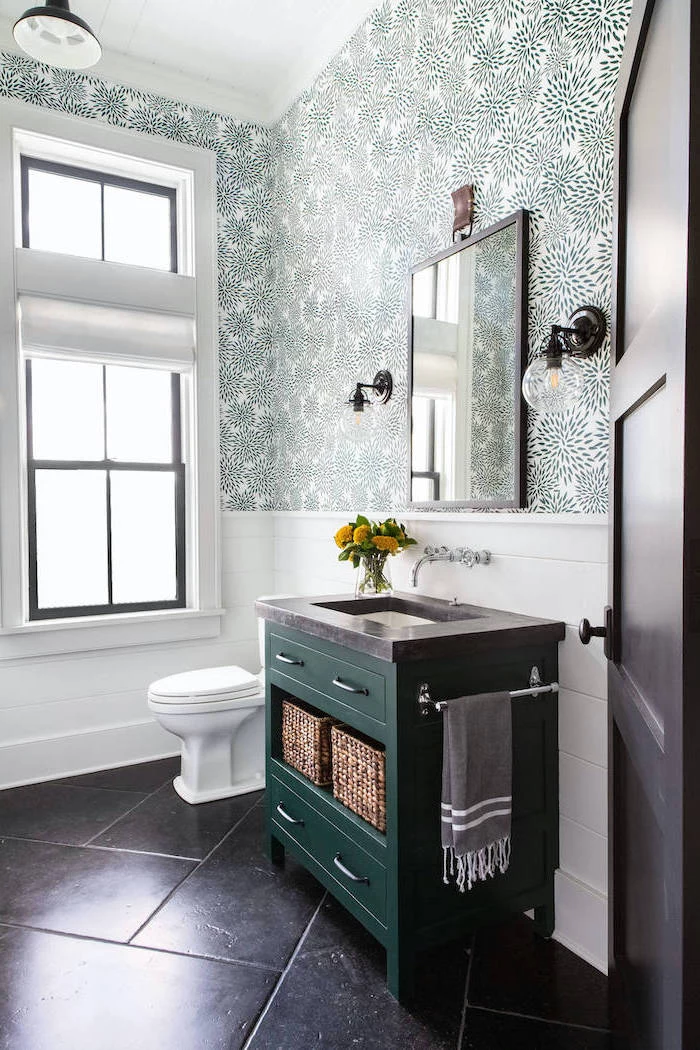
Subway Tile: A Classic for a Reason
Subway tile is timeless, durable, and relatively cheap—it just works. A standard 3×6 white ceramic tile can be found for as low as $2 to $4 per square foot. But the magic is in the details.
Grout color changes everything. Dark gray or black grout creates a bold, graphic look. White or light gray grout feels softer and more seamless. Here’s a pro tip: In showers, I always push for epoxy grout. It costs more and sets fast (so it’s not a great first-timer DIY project), but unlike regular grout, it’s non-porous. That means it resists stains and mildew and you never have to seal it. Worth every penny in the long run.
Picking the Perfect Floor
Bathroom flooring is a huge decision. It has to handle water, humidity, and constant traffic. Here’s the breakdown of your best bets:
- Wood-Look Porcelain Tile: Honestly, this is my go-to for getting the wood look without the worry. Modern porcelain planks are unbelievably realistic. They’re 100% waterproof, tough as nails, and will last forever. For an authentic feel, use planks of different lengths and ask your installer to use a random offset pattern. Cost-wise, you can expect to pay between $5 and $15 per square foot for good quality tile. A luxury touch? Add in-floor radiant heat underneath. It’s an investment (around $10-$20 per square foot, plus an electrician’s fee), but stepping onto a warm floor on a cold morning is pure bliss.
- Luxury Vinyl Plank (LVP): LVP has gotten seriously good. It’s affordable, 100% waterproof, and very DIY-friendly. When you’re shopping, look at the “wear layer” thickness. For a bathroom, don’t get anything less than a 20 mil wear layer. The thicker it is, the better it resists scratches. It’s not real wood, but a high-quality LVP can look fantastic for about $3 to $7 per square foot.
- Real Hardwood: Okay, let’s be real. A real wood floor is gorgeous, but it’s the riskiest choice for a full bath. If your heart is set on it, it has to be perfect. You need dense wood, like reclaimed heart pine, and multiple coats of a marine-grade varnish. Every single drop of water needs to be wiped up immediately. It’s beautiful, but it is absolutely not a low-maintenance option.
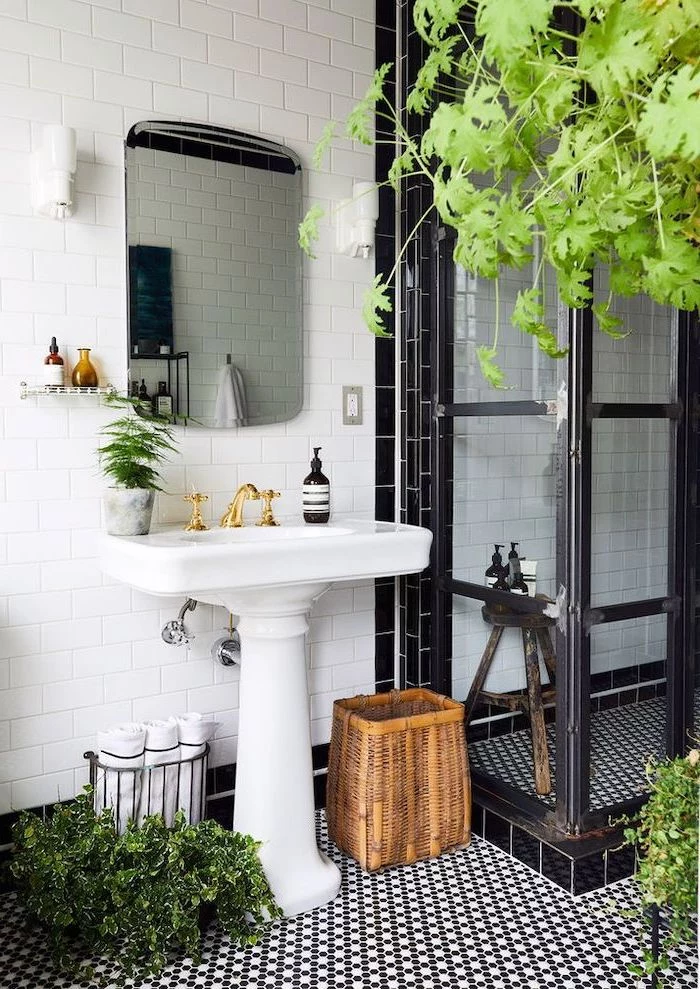
The Big Pieces: Where Function Meets Farmhouse Style
Your vanity, tub, and toilet are the workhorses. This is where you can make a big style statement, but don’t forget about function.
The Vanity and Countertop: Your Bathroom’s Centerpiece
The vanity sets the tone. You can buy one ready-made, or get creative. Repurposing an old dresser or buffet is a fantastic way to get a one-of-a-kind piece. I found a beat-up oak console table at a flea market for $50, spent a weekend reinforcing and sealing it, and turned it into a stunning vanity for a client. It’s the highlight of their bathroom.
If you go this route, though, it’s more than just cutting a hole in the top. Here’s a quick checklist:
- Reinforce it: Add L-brackets to the inside corners to support the weight of a stone top and sink.
- Measure twice, cut once: Figure out your drain and plumbing height before you start modifying drawers to make room for the P-trap.
- Seal everything: Apply at least three coats of marine varnish or oil-based polyurethane, inside and out. Pay extra attention to any new cuts you made.
For the countertop, you have a few great options:
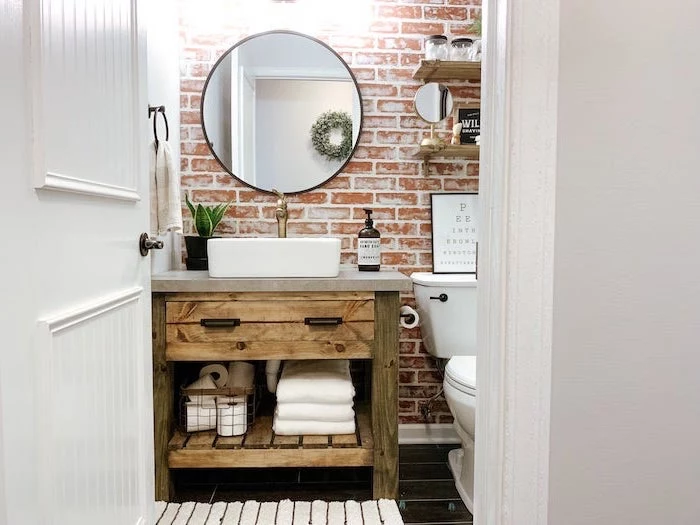
- Quartz: This is a popular, durable, non-porous choice that comes in tons of styles that can mimic marble or soapstone without the maintenance. It’s a solid, worry-free option.
- Soapstone: I love soapstone. It has a beautiful, matte, old-world feel. It’s dense and won’t stain, but it’s a softer stone, so it can scratch. Over time, it develops a deep, dark patina that is just gorgeous.
- Butcher Block: A wood top offers incredible warmth, but like a wood floor, it needs serious sealing with something like a marine varnish and diligent care to prevent water damage.
The Tub: A Place to Soak It All In
A freestanding clawfoot tub is the quintessential farmhouse statement piece. But before you fall in love, you have to think about weight. A vintage cast iron tub can weigh 300-500 pounds… before you add 40 gallons of water and a person. On a second-floor bathroom, this is a major concern.
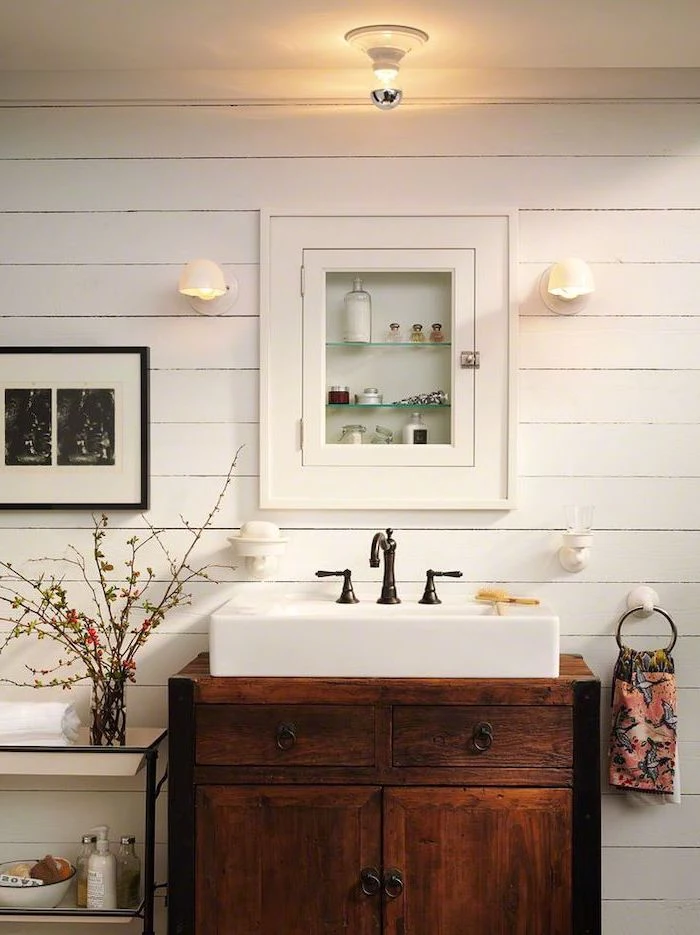
Heads up! I require a consultation with a structural engineer before installing one on an upper floor. It’s not optional. They’ll tell you if your floor joists can handle the load. Expect this consultation to cost between $300 and $700. It’s a small price to pay for knowing your tub won’t end up in the living room.
Quick Wins: A Farmhouse Refresh on a Budget
Don’t have the time or money for a full gut job? You can still get a big dose of that farmhouse charm with a few weekend projects.
- Paint & Hardware: Paint your existing vanity a classic white, gray, or even a moody dark green. Swap out the old knobs and pulls for matte black or oil-rubbed bronze hardware. This is a $100 project that can completely change the feel of the room.
- Update the Mirror: Ditch the basic plate-glass mirror and hang a framed wood mirror instead. You can often find great ones at thrift stores or home goods stores for under $150.
- Change the Light Fixture: Swapping a dated vanity light bar for a pair of gooseneck sconces or a simple, rustic fixture can make a huge impact.
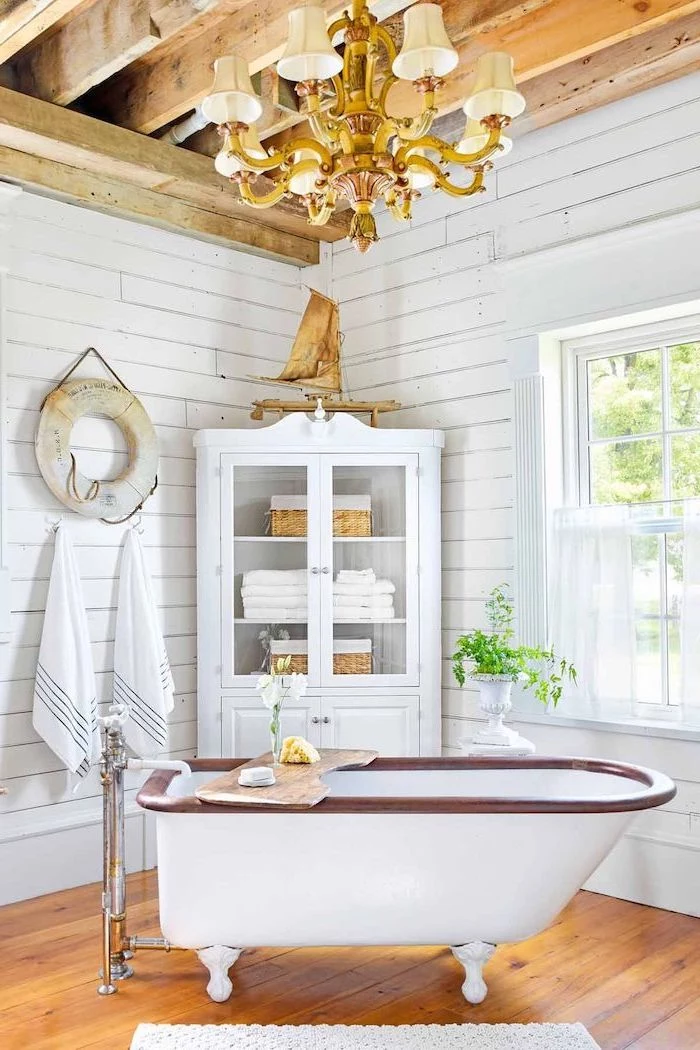
The Details That Tie It All Together
Once the big pieces are in, the small stuff—lighting, faucets, hardware—is what brings the whole look home.
Lighting for Vibe and Safety
Good lighting is critical in a bathroom. Your electrician will know this, but any fixture directly over a tub or in a shower needs to be “wet-rated.” Other lights in the room should be “damp-rated.” It’s a non-negotiable safety code.
For the most flattering light, put sconces on either side of your vanity mirror instead of one light above it. It eliminates shadows and just looks better.
Faucets and Finishes
The faucet is the jewelry of the bathroom. The finish you pick has a huge impact on look and maintenance.
- Unlacquered Brass: This is a “living finish.” It starts out shiny and develops a beautiful, warm patina over time. I love the authentic, evolving character. If you want to keep it bright and polished, though, you’ll need to break out the Brasso every few months.
- Matte Black: Looks incredibly sharp and modern, but it can show water spots, especially if you have hard water.
- Oil-Rubbed Bronze: A very forgiving, dark finish that has an aged look right from the start. It pairs beautifully with wood tones.
For style, a “bridge” faucet, where the hot and cold handles are connected by an exposed pipe, is a classic choice. A good one can run you anywhere from $250 to over $800, but it makes a statement.
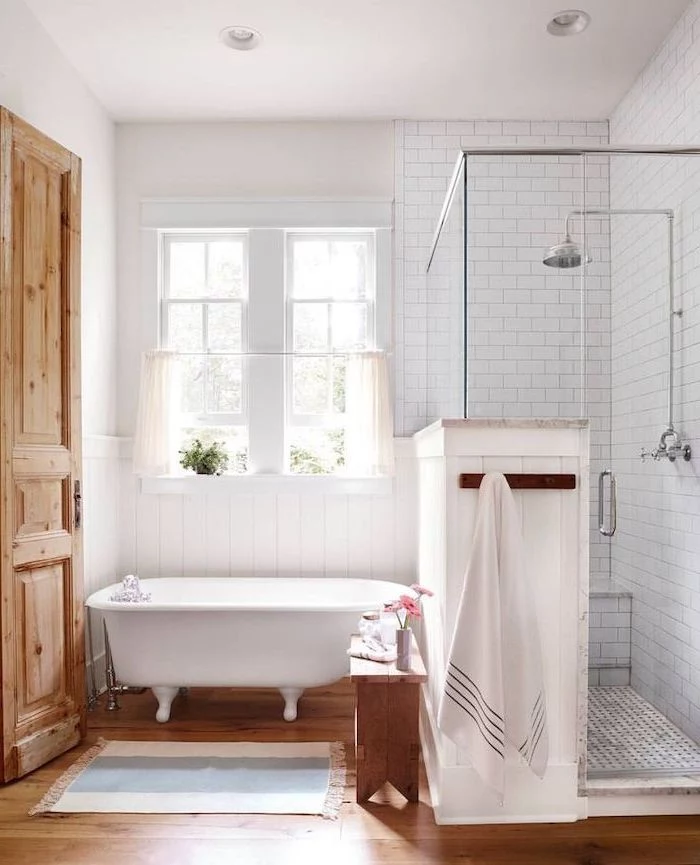
Knowing When to DIY and When to Call a Pro
I’m all for homeowners getting their hands dirty, but it’s crucial to know your limits, especially in a bathroom.
Painting, swapping a faucet (if the plumbing isn’t moving), and changing hardware are great DIY projects. But for electrical work, moving plumbing lines, or waterproofing a shower? Hire a licensed and insured professional. Period.
That waterproofing behind your shower tile is the most important part of the job you’ll never see. We use membranes or liquid products—think of it like a thick, rubbery paint that makes the wall totally waterproof. Messing this up is the #1 cause of catastrophic bathroom failures.
By the way, a pro tiling job for a standard shower might take 2-3 days. A full gut renovation of a small bathroom? Block out at least 3 to 6 weeks. Delays with materials and subcontractors are common, so build in a buffer.
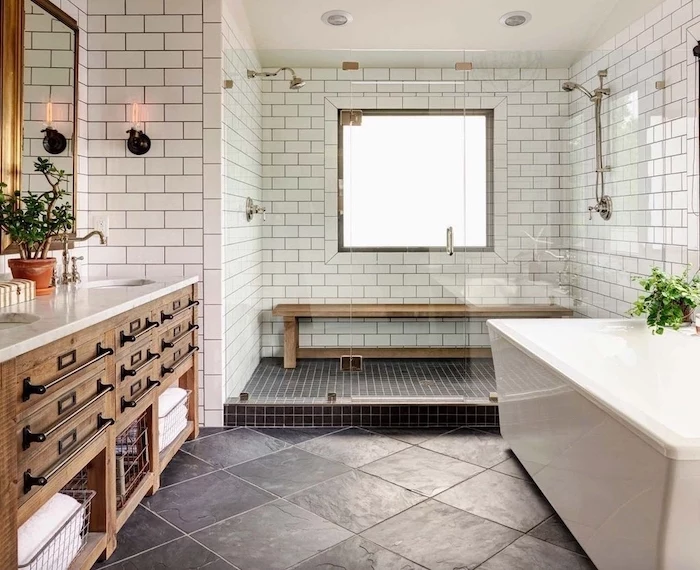
The saying “pay me now or pay me later” is never truer than in a bathroom. The money you save trying to DIY complex plumbing will be a drop in the bucket compared to the cost of fixing a major leak. Plan carefully, invest in quality where it counts, and you’ll create a beautiful, functional space you’ll love for years to come.
Inspirational Gallery
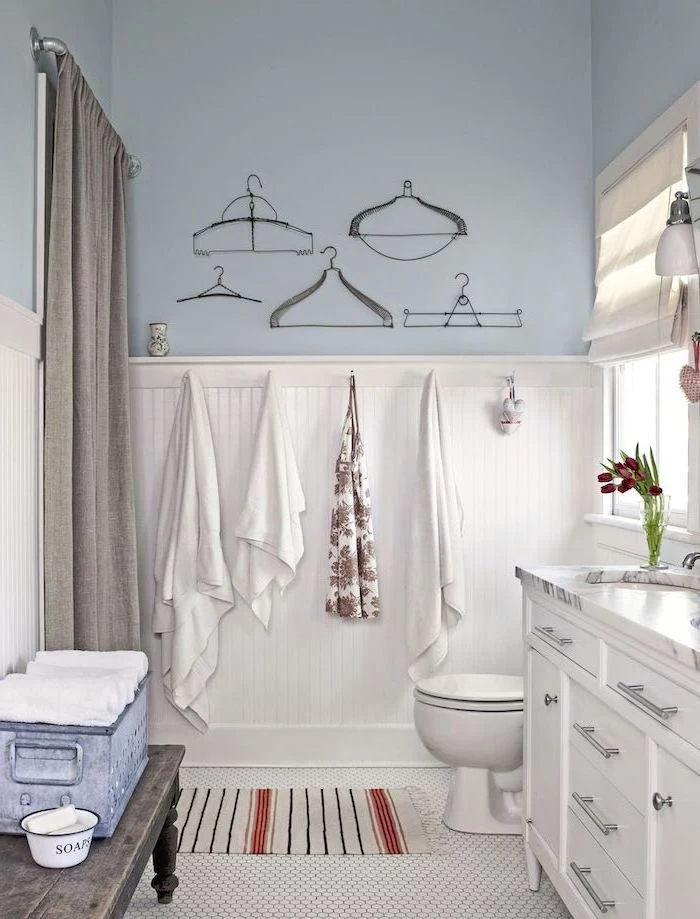
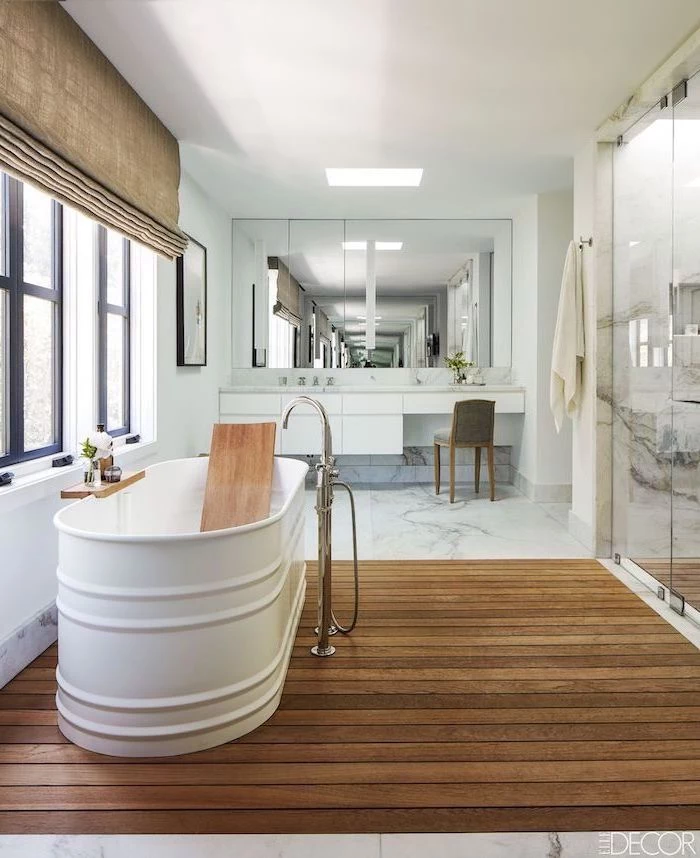
Quartz Countertops: Engineered stone that offers a non-porous, scratch-resistant, and maintenance-free surface. Brands like Caesarstone or Silestone offer convincing marble-look options without the risk of staining from toiletries.
Honed Marble: Delivers classic, authentic beauty but is porous and softer. It will etch and develop a patina over time, which some homeowners love. It requires regular sealing to resist moisture and stains.
For a truly durable farmhouse bathroom that sees heavy family use, quartz is the worry-free winner.
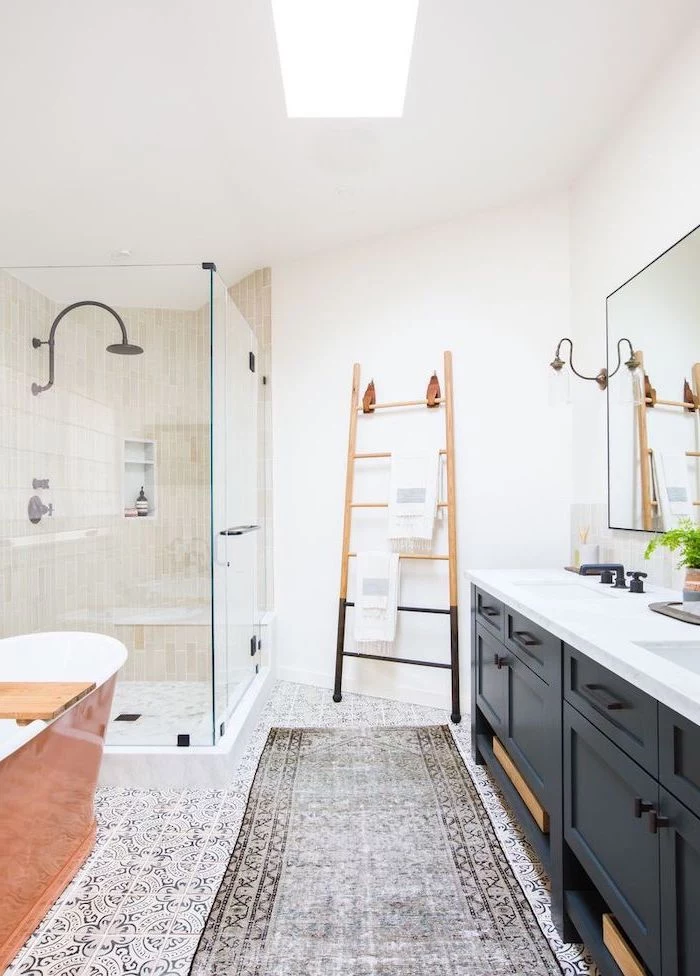
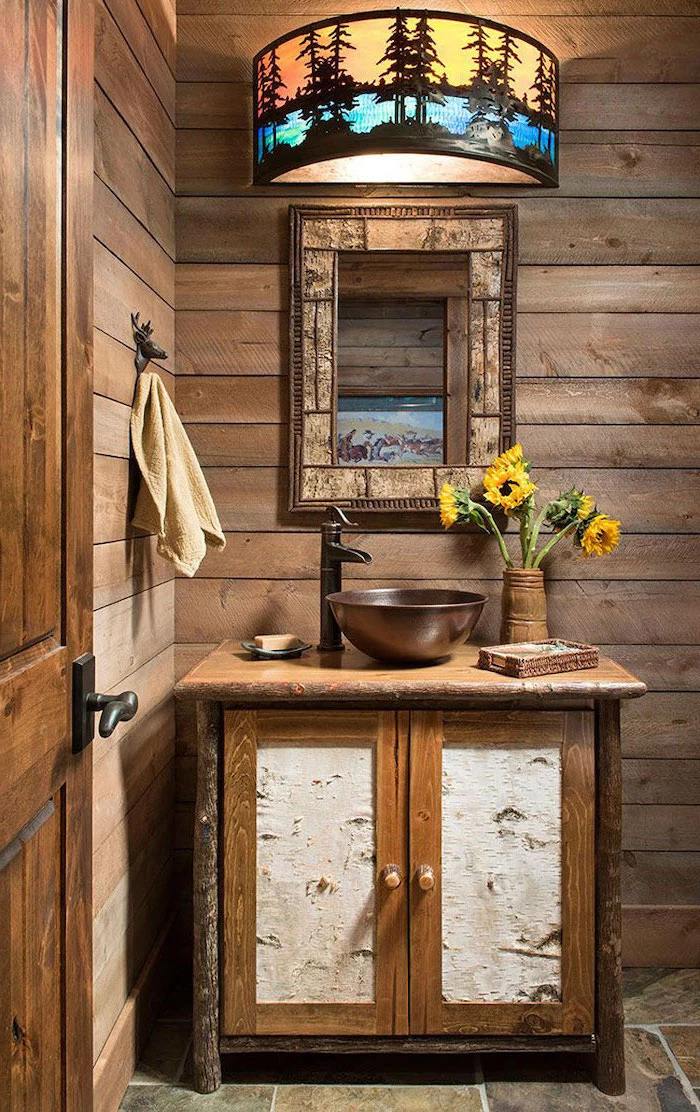
The National Kitchen & Bath Association recommends that a bathroom’s exhaust fan be capable of exchanging the air at least eight times per hour.
This isn’t just about preventing foggy mirrors. A properly sized, quiet fan from a brand like Panasonic is your number one defense against the mold and mildew that can destroy wood vanities and drywall from the inside out. Don’t hide a cheap, noisy fan behind a pretty vent cover; invest in one that truly does the work.
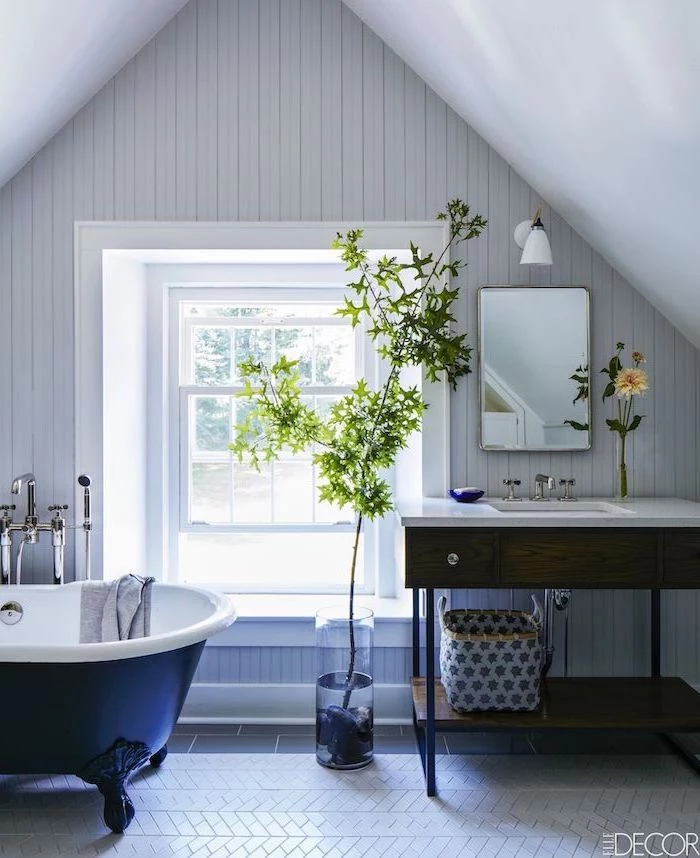
When selecting your faucet, think beyond the look. A matte black finish offers a striking modern contrast, but can show water spots and fingerprints more easily. Unlacquered brass is a living finish that will tarnish and age beautifully, developing a unique patina. For a classic, low-maintenance choice, a brushed nickel finish from a reputable brand like Delta or Moen often provides the best balance of style and durability against hard water and cleaning products.
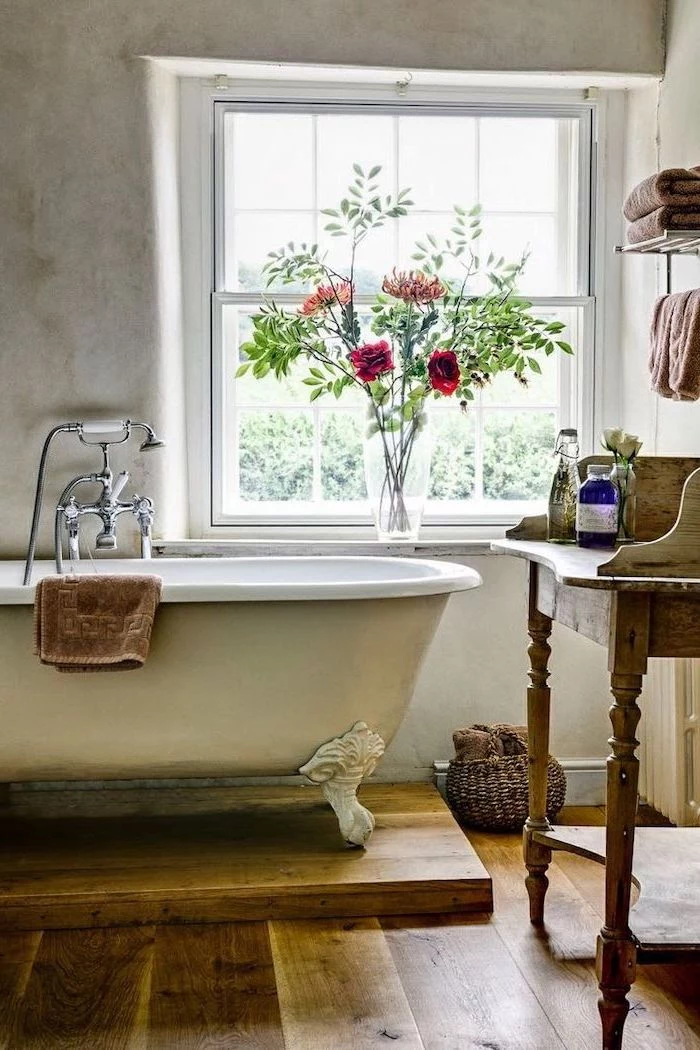
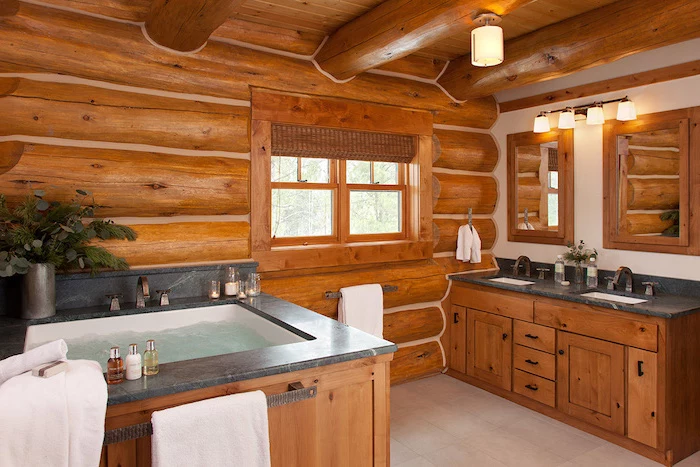
Can you really put wood floors in a bathroom?
It’s a high-risk, high-reward choice. If you’re set on the look, avoid solid hardwood which will warp with humidity changes. Instead, opt for luxury vinyl plank (LVP) flooring. Modern LVP from brands like COREtec offers hyper-realistic wood looks, is 100% waterproof, and feels warmer underfoot than tile. It gives you the farmhouse aesthetic without the constant fear of water damage.
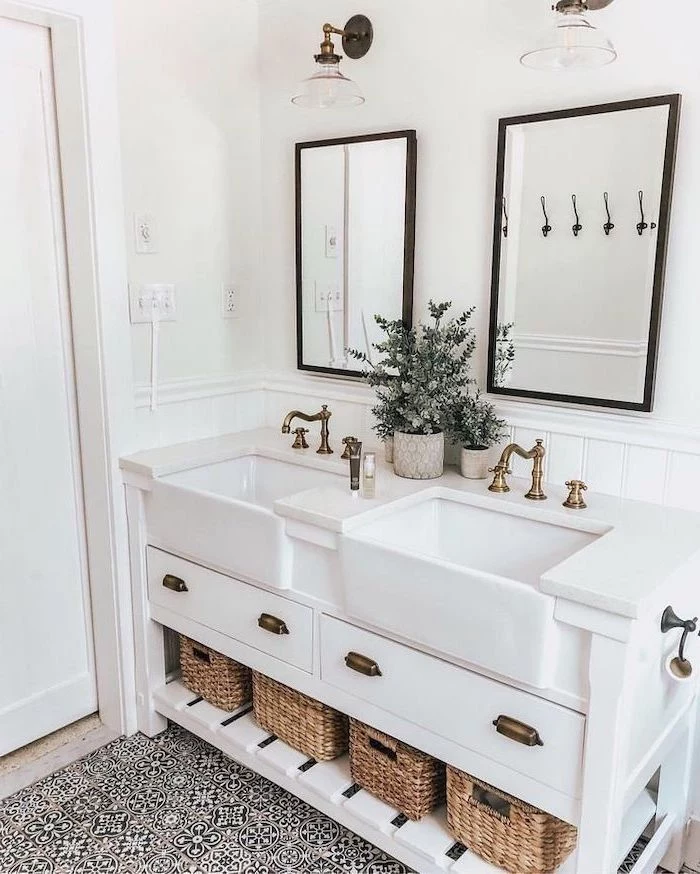
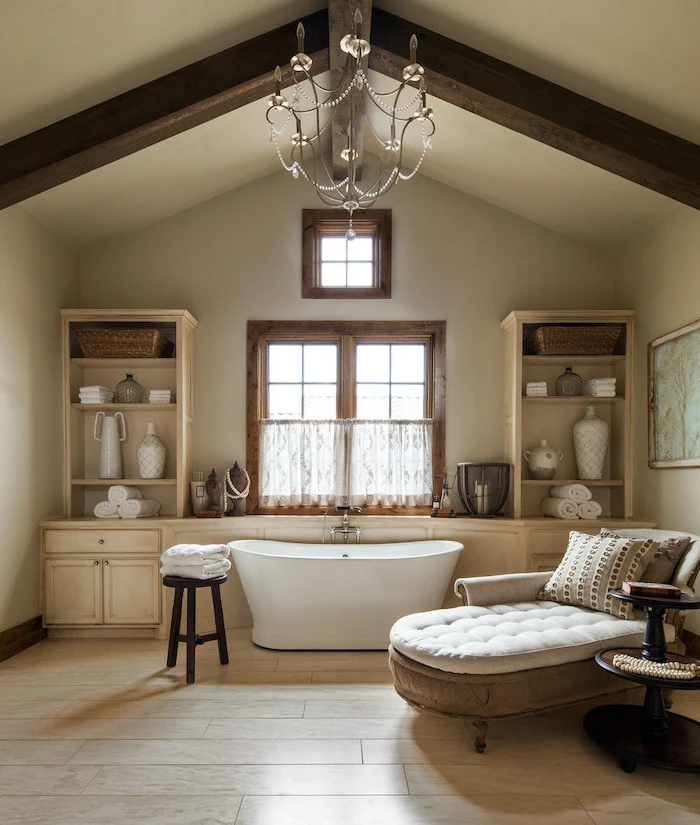
- Resists rot, mildew, and insects.
- Won’t warp or swell due to moisture.
- Holds paint perfectly without priming.
The secret? Using PVC trim boards for your shiplap in wet zones. While pine shiplap is great for a feature wall, in a shower or directly behind a freestanding tub, using AZEK or a similar cellular PVC product milled with a nickel-gap profile gives you the identical look with zero risk of water damage.
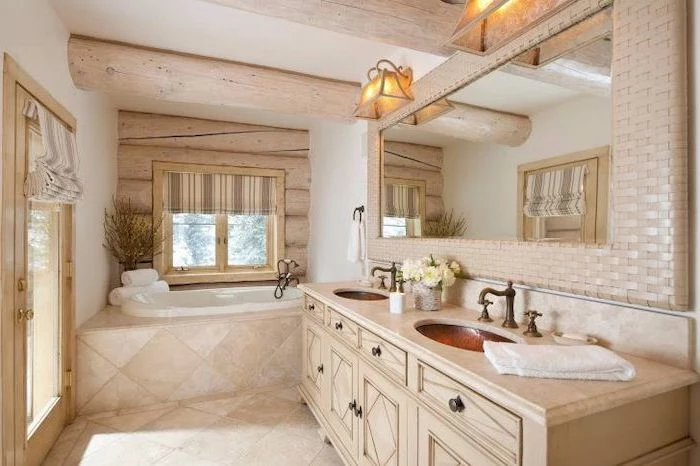
The right lighting is non-negotiable. A single overhead fixture creates harsh shadows. For a functional and flattering setup, layer your lighting. Place wall sconces on either side of the mirror, about 66 inches from the floor, to illuminate your face evenly. Supplement with a central ceiling fixture for general brightness and a dedicated, wet-rated light in the shower.
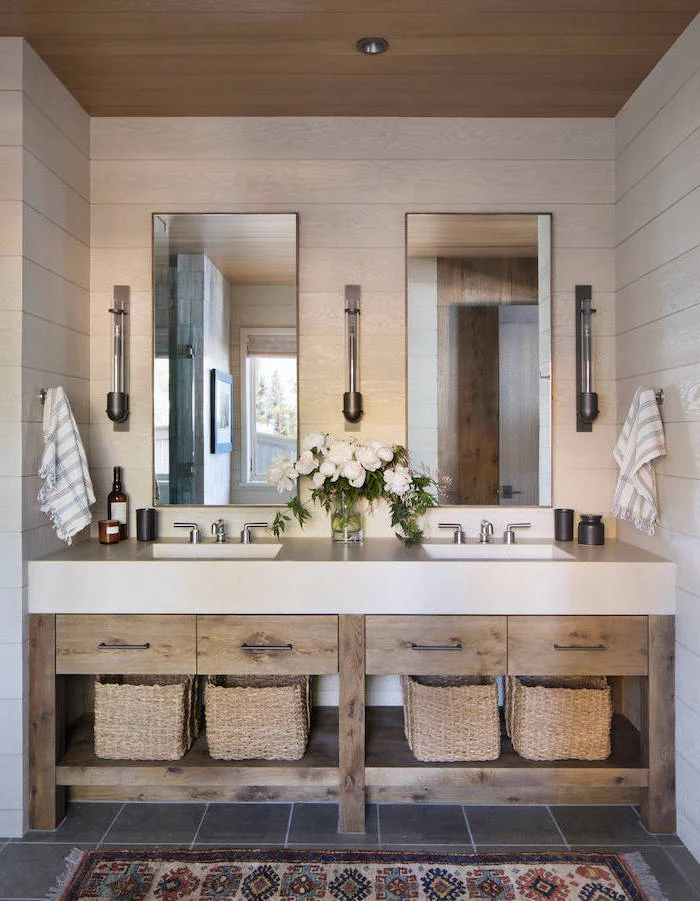
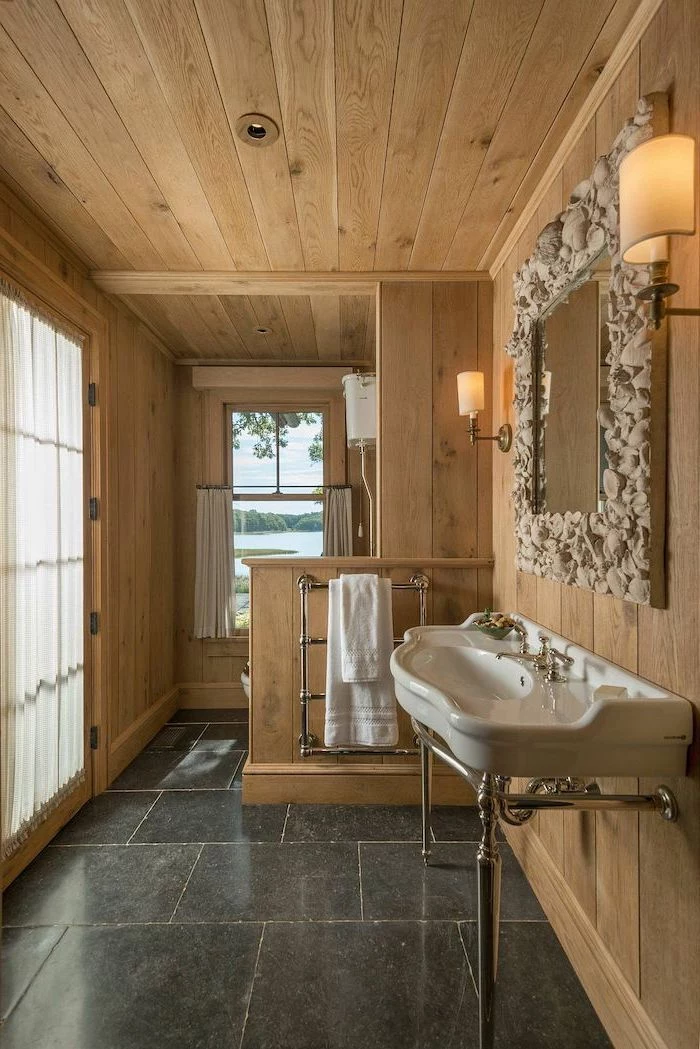
Beyond the classic pedestal sink, consider these authentic farmhouse options:
- Vessel Sink: A bowl-style sink sitting atop the counter. Choose a substantial, non-porous material like fireclay or stone, and pair it with a taller vessel faucet.
- Trough Sink: These long, deep sinks, often with two faucets, are a nod to historic washrooms. They’re perfect for shared bathrooms and make a strong style statement. Look at models from Native Trails for inspiration.
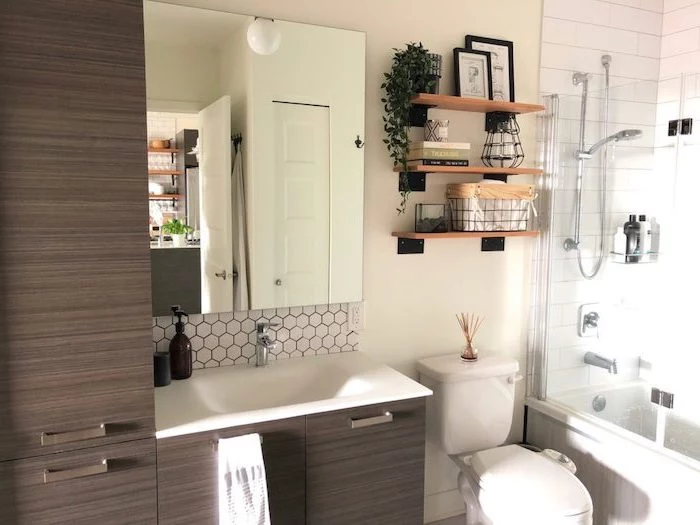
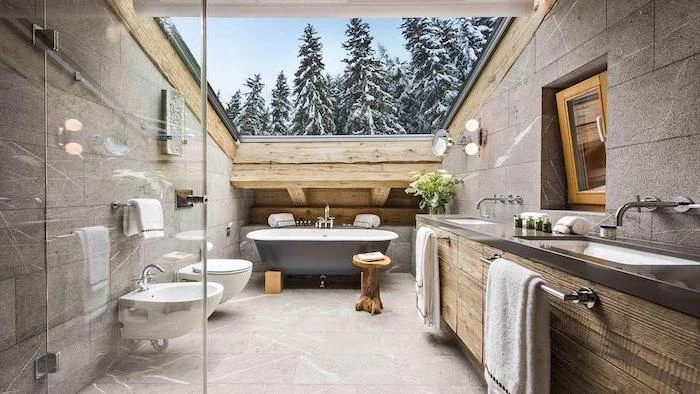
Fact: The average cost to move a toilet just a few feet can range from $500 to $3,500 due to complex plumbing and flooring work.
Before you fall in love with a new layout, get a quote from a licensed plumber. Often, the most budget-friendly and durable renovation works with the existing plumbing footprint. Designing your farmhouse dream around the current drain and supply lines can save you thousands and prevent potential future leaks from new, complex connections.
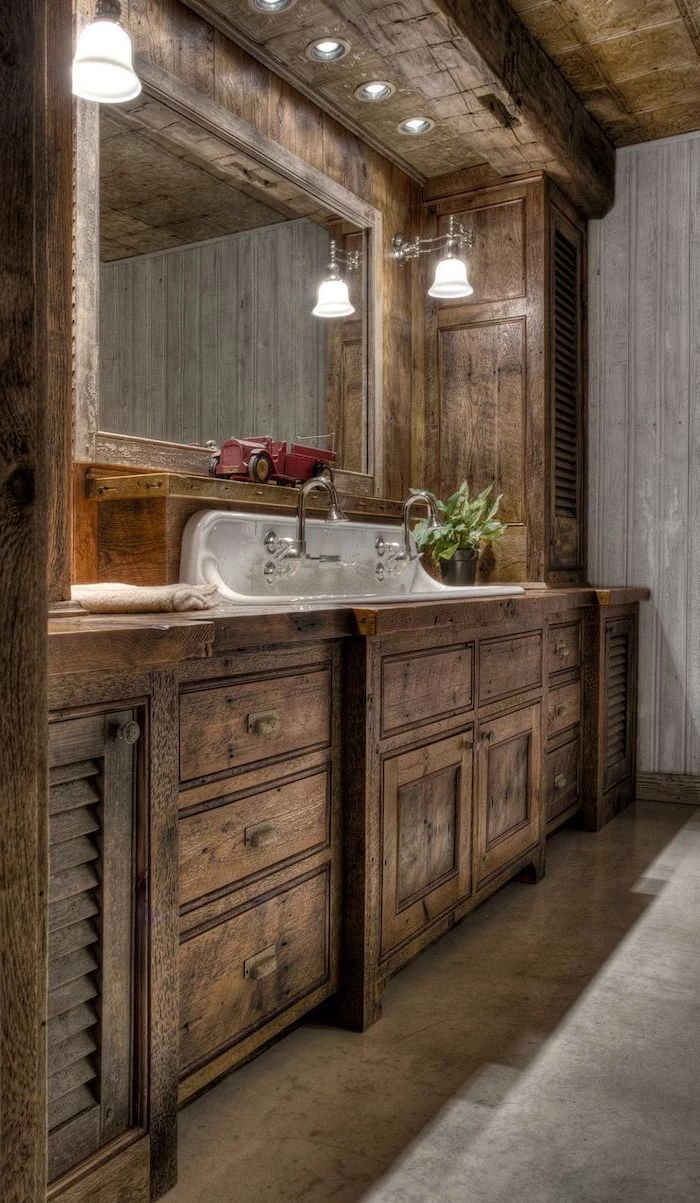
Your vanity hardware is the jewelry of the room. Don’t be afraid to mix materials for an authentic, collected-over-time feel. For a classic farmhouse look, pair a stained wood vanity with matte black cup pulls on the drawers and simple black knobs on the doors. Brands like Rejuvenation and Schoolhouse offer high-quality, period-appropriate hardware that feels substantial in your hand.
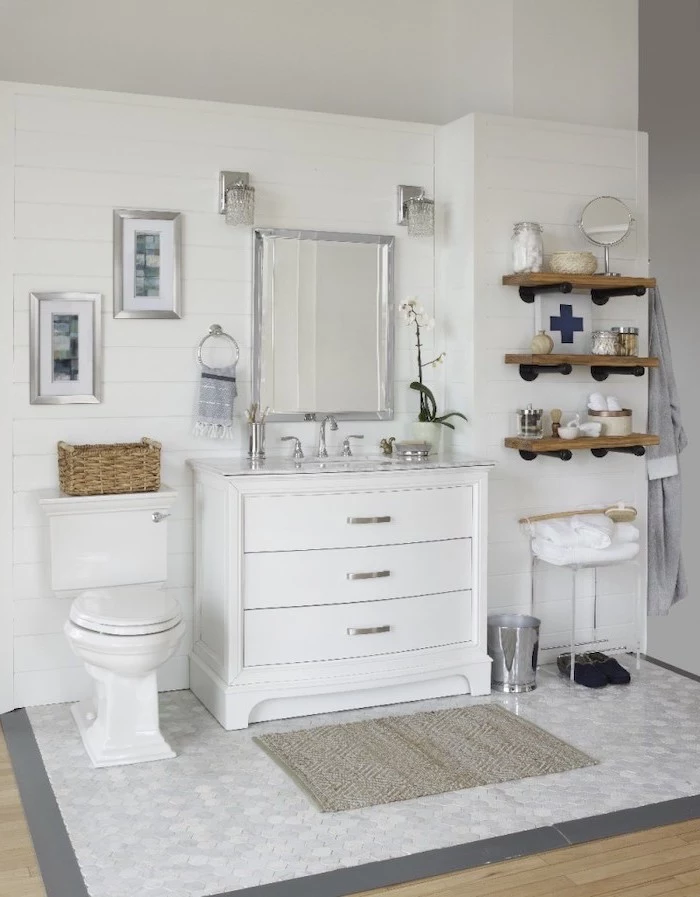
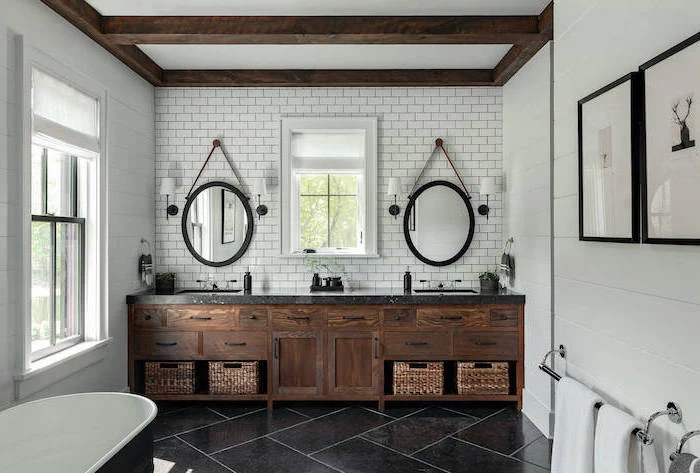
Is wallpaper a terrible idea in a steamy bathroom?
Not if you do it right. Avoid putting traditional paper in direct splash zones. For powder rooms or on walls away from the shower, use modern ‘paste-the-wall’ papers which are often more durable. For extra protection, some designers apply a coat of clear matte decorator’s varnish, like Polyvine’s Dead Flat Varnish, over the top to make it wipeable and resistant to humidity.
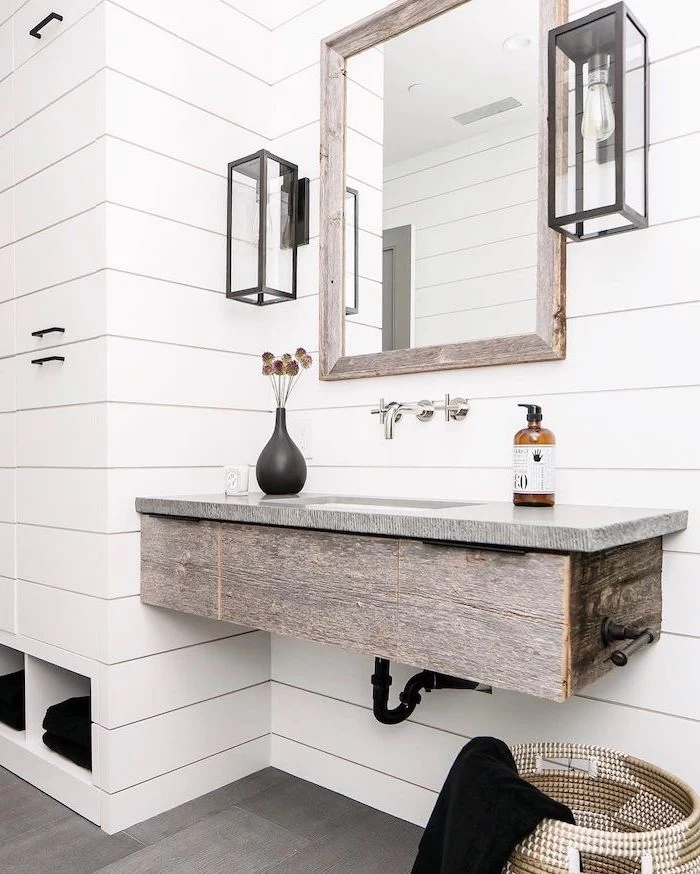
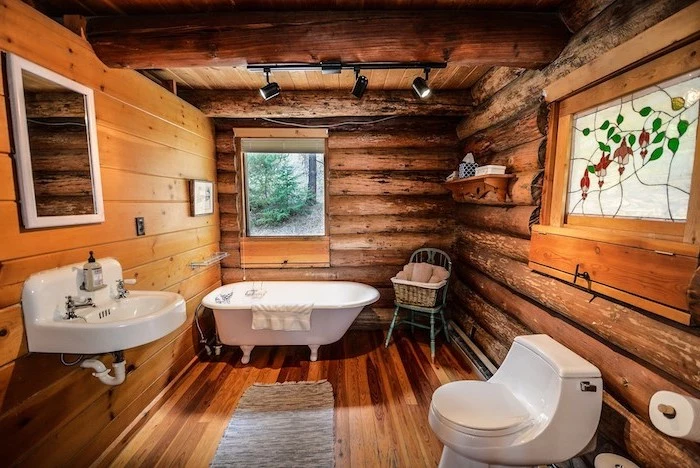
Reclaimed wood carries character, but it can also carry moisture, pests, or lead paint.
If you’re using salvaged barn wood for a feature wall or shelving, ensure it is properly kiln-dried to kill any insects and stabilize the wood. Always test for lead paint if the wood is painted, and seal the finished surface with a matte, water-based polyurethane to lock in splinters and make it easy to clean.
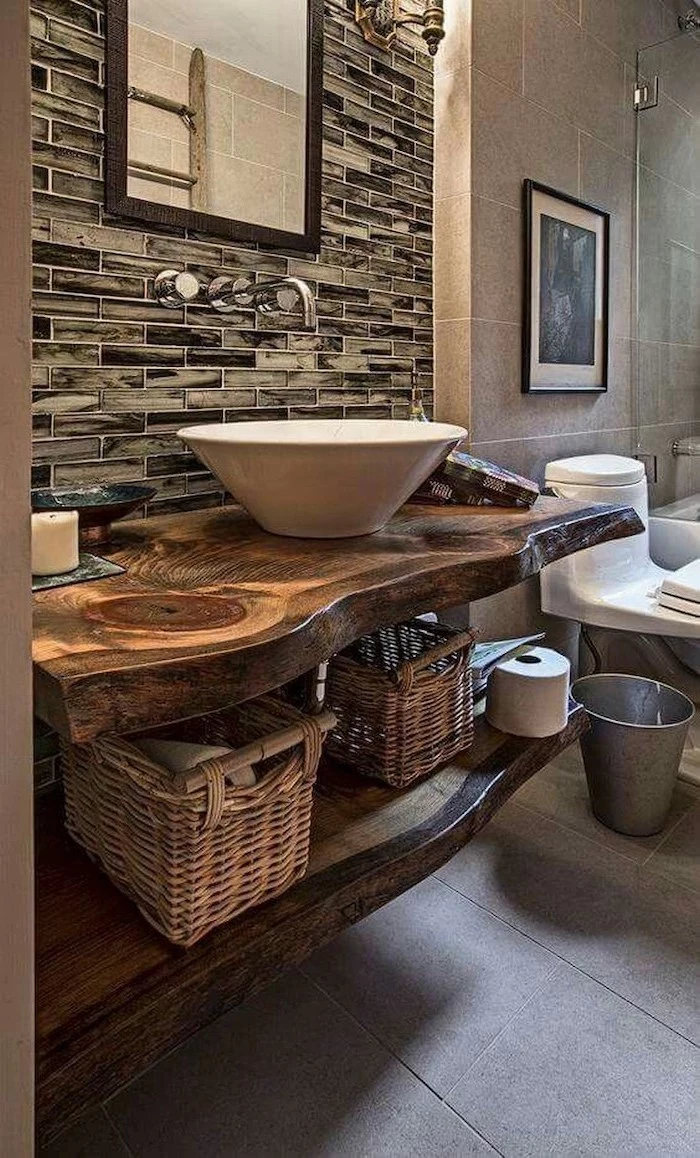
Crucial detail: The paint you use matters as much as the color. Standard wall paint will peel and mildew in a high-humidity environment. You must use a paint specifically formulated for bathrooms. Benjamin Moore’s AURA Bath & Spa or Sherwin-Williams’ Duration Home Interior with Moisture-Resistant Technology are designed to withstand steam and prevent water-streaking and mold growth.
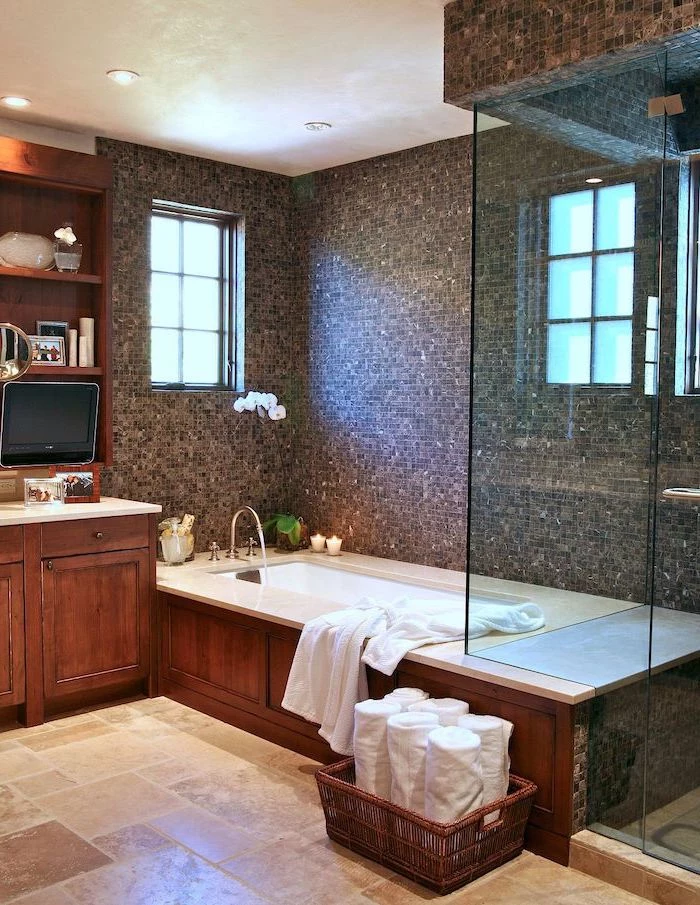
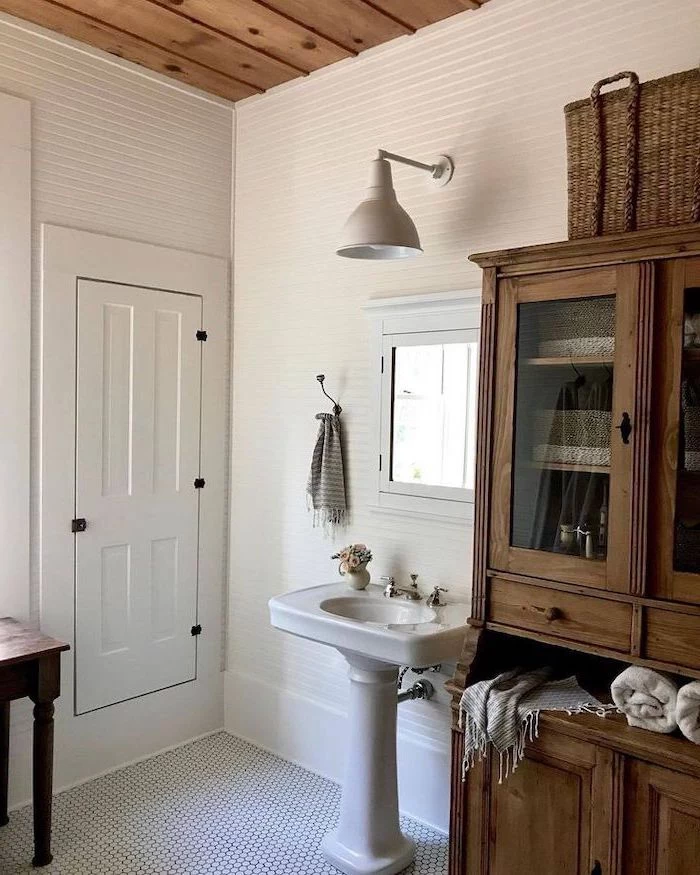
- Anchor the faucet finish (e.g., matte black).
- Choose a secondary metal for lighting and mirrors (e.g., aged brass).
- Select a third, subtle metal for hardware and accessories (e.g., brushed nickel or iron).
A simple rule for mixing metals without creating chaos is the ‘Rule of Three’. Using a dominant, secondary, and accent metal creates a look that feels curated, not chaotic.
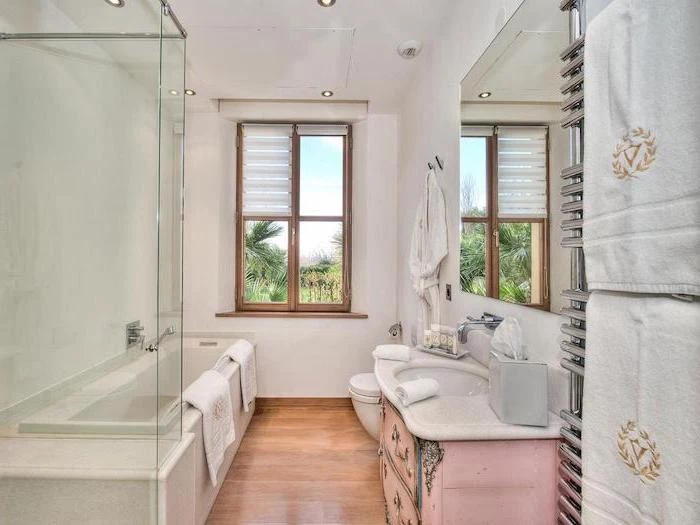
For a shower that blends farmhouse style with modern performance, ditch the flimsy acrylic insert. Opt for a tiled shower pan and walls. Use a classic 3×6 white subway tile, but lay it in a herringbone or vertical stack pattern for a subtle update. For the floor, a mosaic hex or penny tile not only looks period-appropriate but also provides more grout lines for better slip resistance.
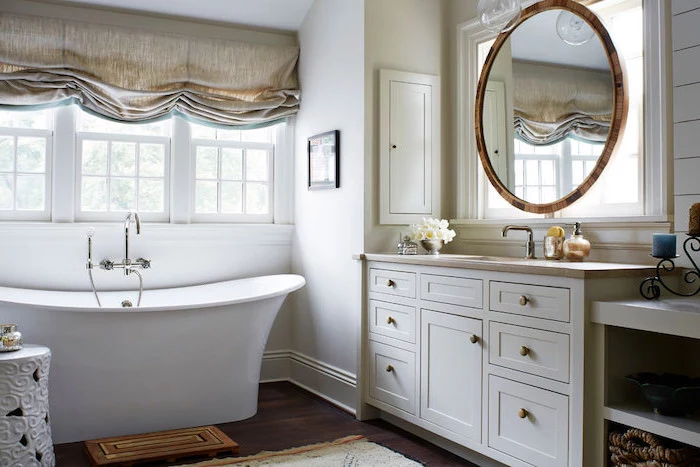
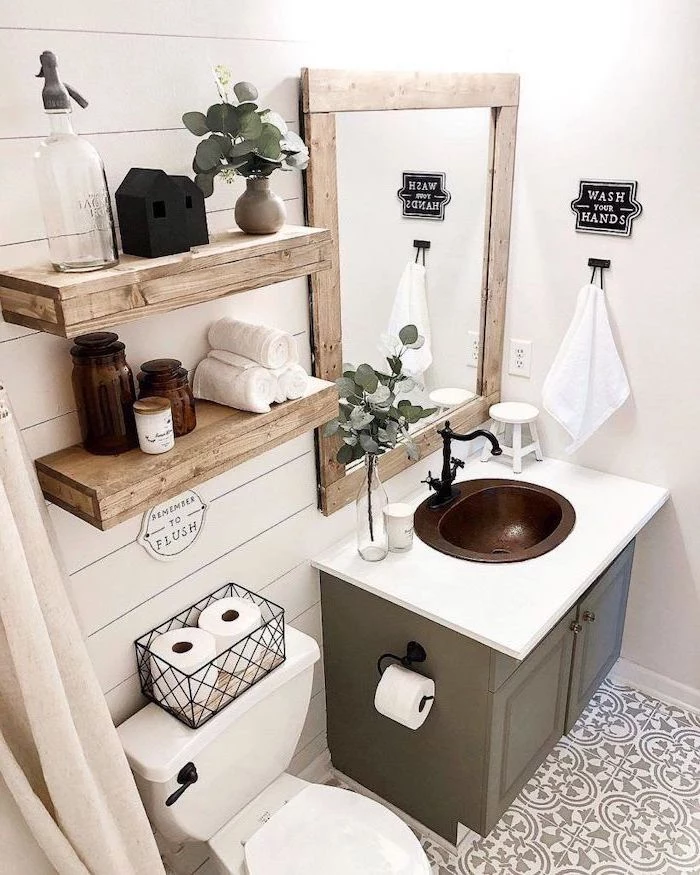
Porcelain Tile: A denser, less porous, and harder type of ceramic tile. It’s an excellent choice for bathroom floors as it’s highly water-resistant and durable. Many porcelain tiles are now printed to look exactly like cement tile, giving you the pattern without the maintenance.
Cement Tile: Beautiful and handcrafted, but also porous and prone to staining if not sealed meticulously and regularly. It’s much softer than porcelain and can be etched by acidic cleaners.
For a bathroom built for real life, patterned porcelain is the safer bet.
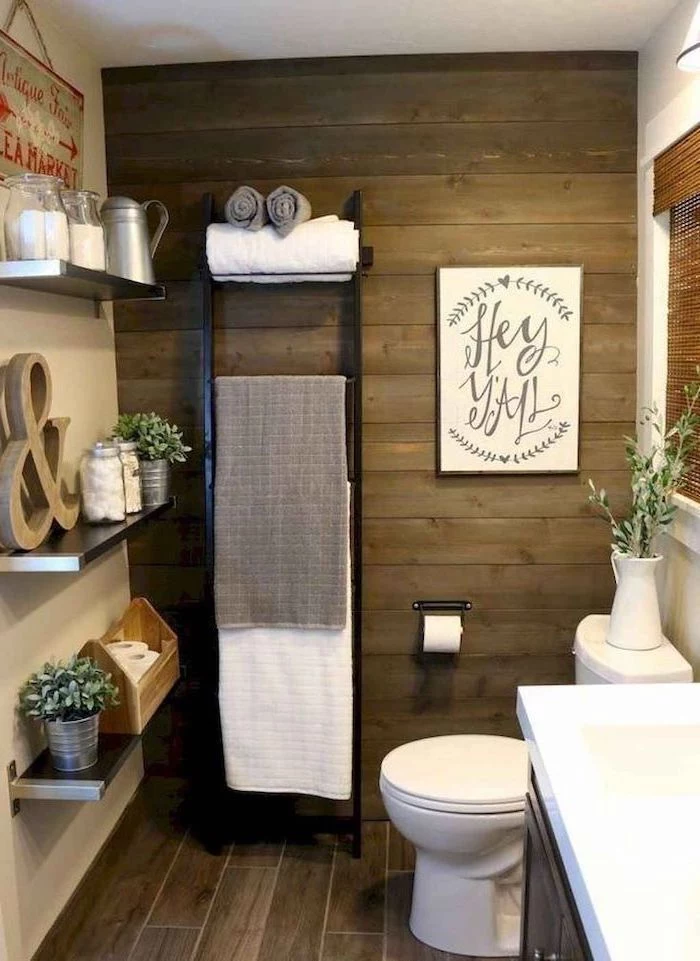
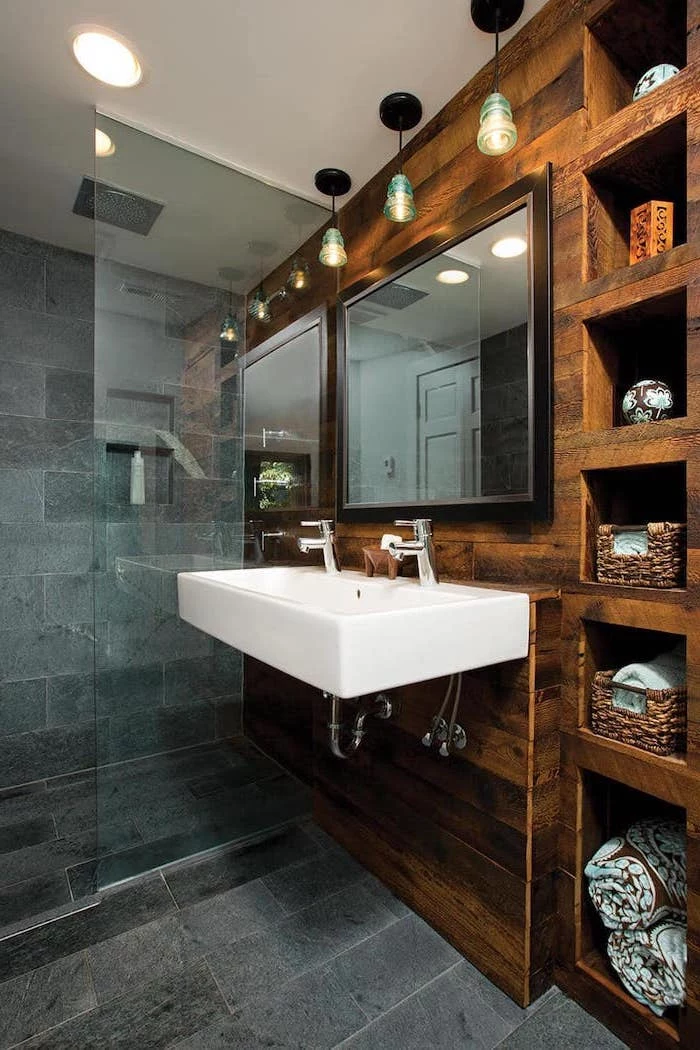
A vintage-style mirror can be a fantastic focal point, but don’t just hang any old frame. Bathroom humidity can damage wood frames or cause the silvering on the back of old mirrors to flake. Look for new mirrors designed with a vintage aesthetic or have a custom frame built from a moisture-resistant material. Sealing the back edges of a true vintage find with a clear sealant can also help prolong its life.
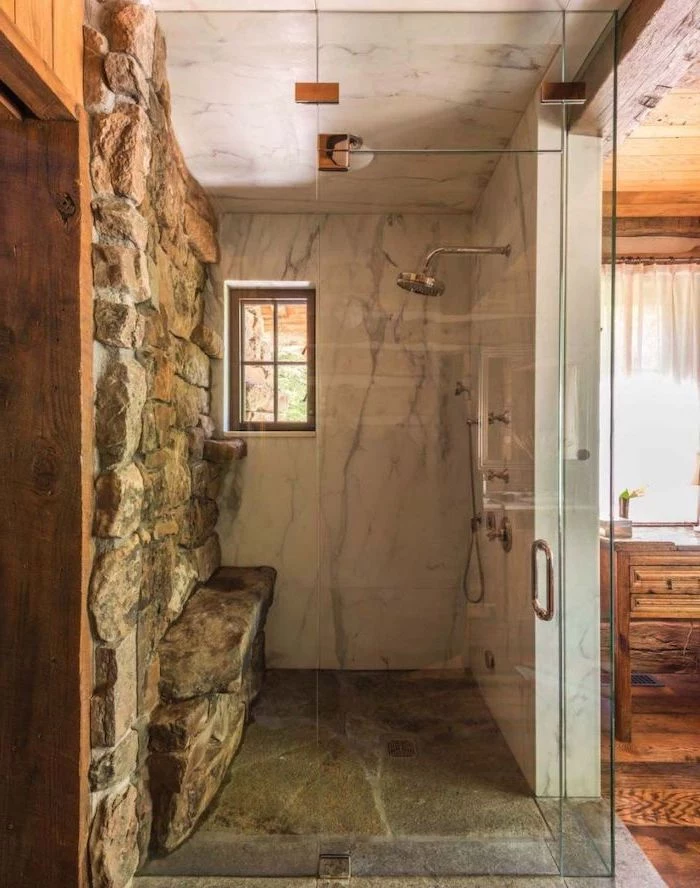
- A feeling of quiet solidity.
- Better sound insulation from the rest of the house.
The secret? A solid-core door. While often overlooked, upgrading from a standard hollow-core door adds a surprising sense of quality and luxury. The weight and sound-dampening properties make the bathroom feel more like a private, peaceful retreat—a small investment with a big impact on the room’s atmosphere.
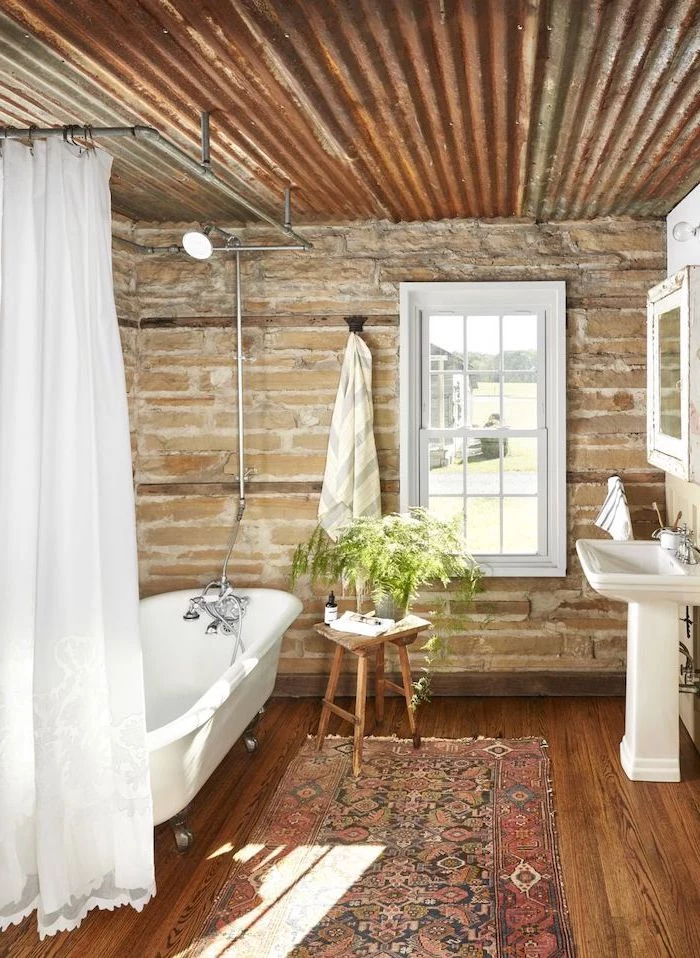
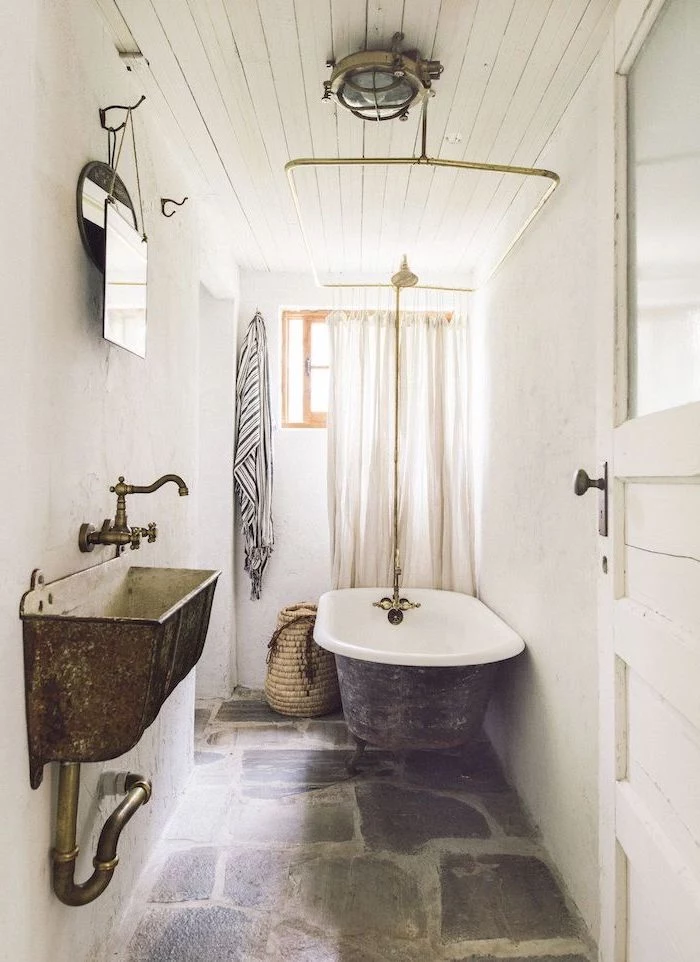
The choice of grout can dramatically change your tile’s appearance. While white grout with white subway tile is classic, it’s notoriously hard to keep clean. Consider a medium-gray or taupe grout instead. It hides dirt, adds a subtle graphic pattern that highlights the shape of the tile, and gives a more authentic, aged farmhouse feel. For maximum durability, always use a high-performance, stain-resistant grout.
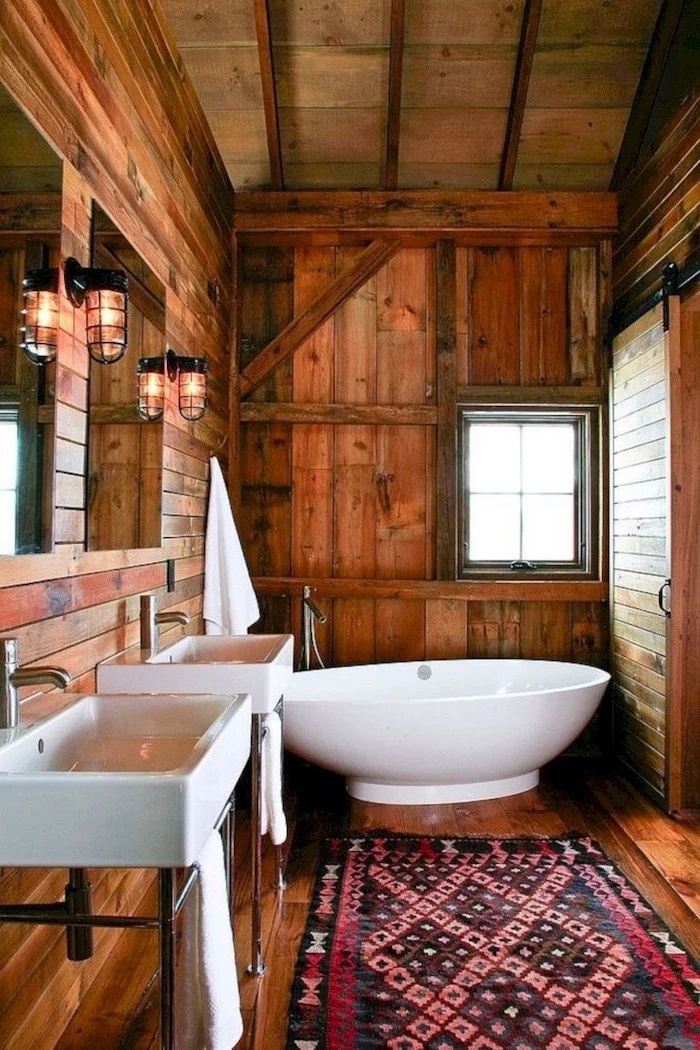
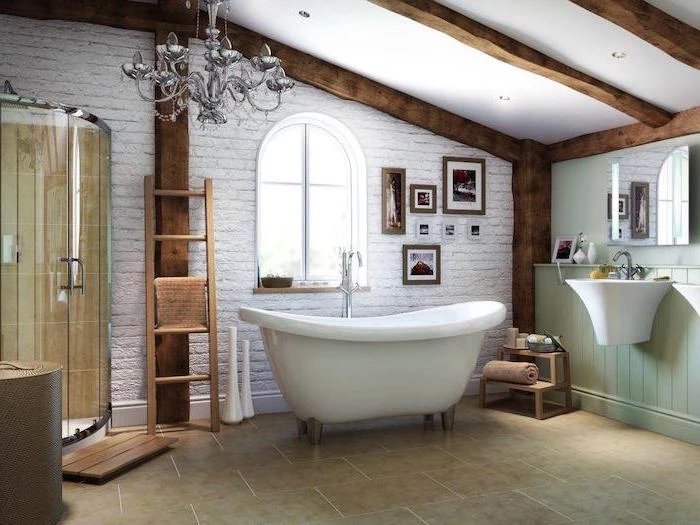
How do I add farmhouse charm on a tight budget?
Focus on high-impact, low-cost swaps. Changing out the builder-grade mirror for a large, round or wood-framed one can transform the space. Replace the faucet and cabinet hardware. Update the light fixture to something with more character, like a gooseneck barn light. These changes don’t require major demolition but can completely redefine the room’s style.
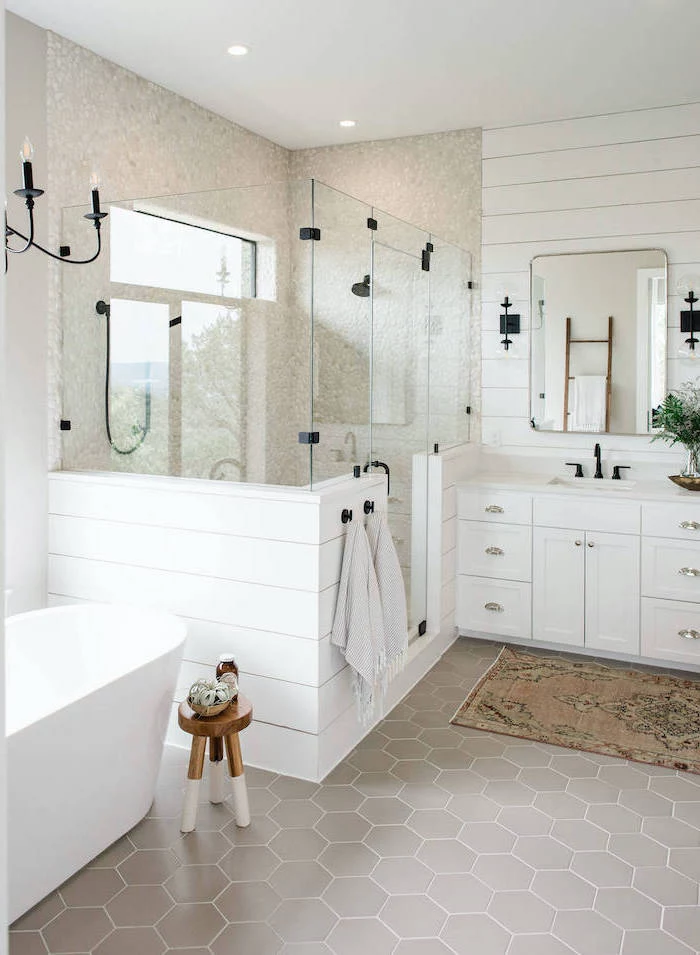
Important point for freestanding tubs: Don’t cram it into a corner. The beauty of a freestanding tub lies in its sculptural form, which needs space to be appreciated. Plan for at least 6-8 inches of clearance around the entire tub. This not only looks better but is a practical necessity for cleaning behind and around it, preventing a dust- and grime-filled dead zone.
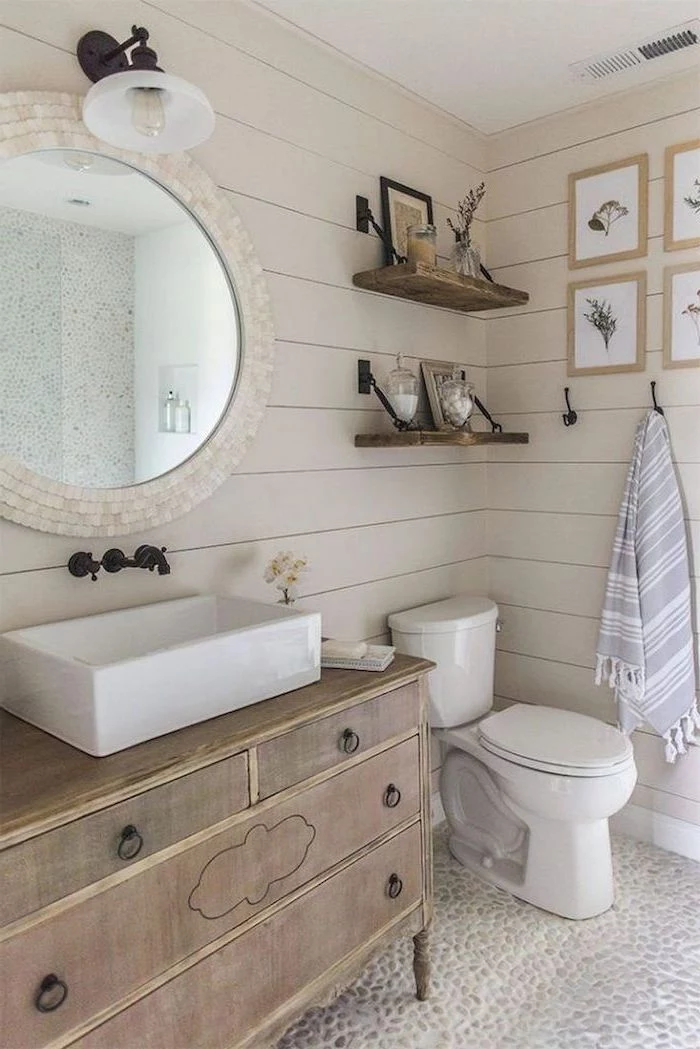
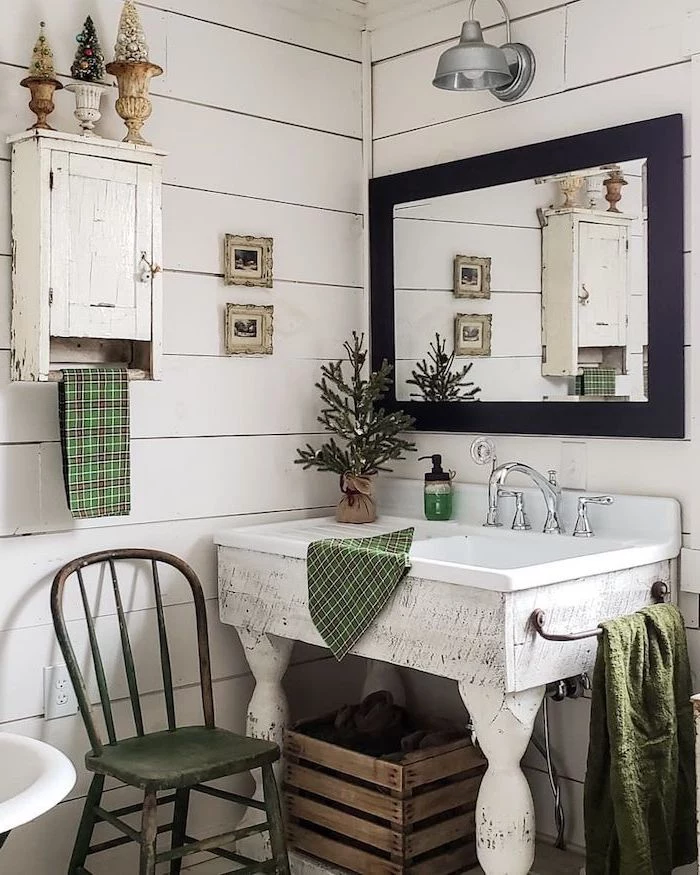
For privacy and light control, fabric roman shades or simple woven-wood blinds are a perfect fit for the farmhouse aesthetic. Avoid heavy drapes that can hold moisture and feel out of place. Ensure any fabric treatment is at least a few feet away from the tub or shower spray, or opt for faux-wood blinds which are completely waterproof and easy to clean.
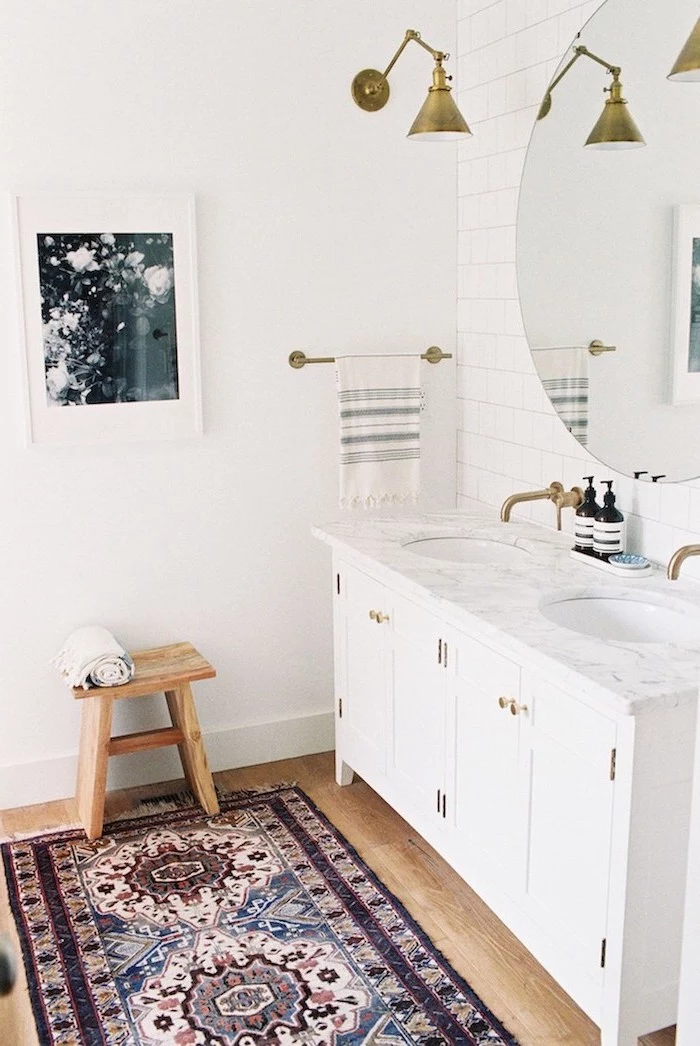
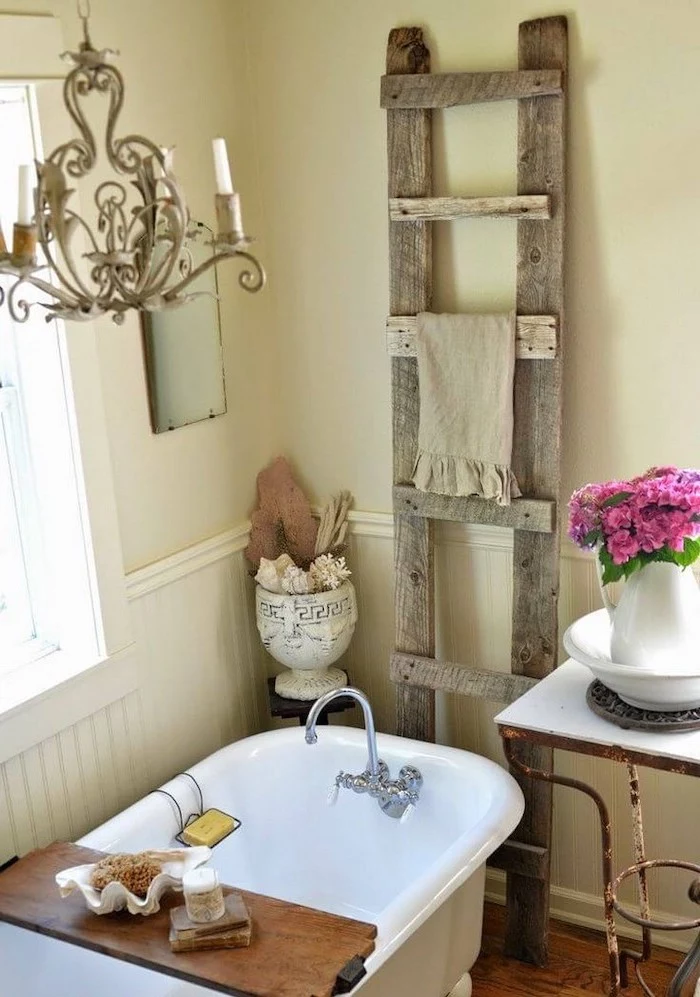
A single trough sink can weigh over 150 pounds before water is even added.
If you’re planning on a substantial fireclay or concrete trough sink, you can’t just place it on any old vanity. The cabinet must be reinforced, often with additional wood blocking secured to wall studs, to safely support the weight over the long term. This is a structural detail your contractor must not overlook.
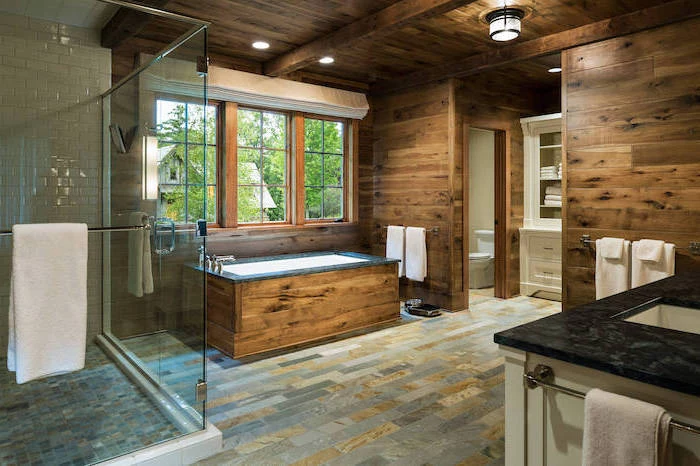
Open shelving is a hallmark of the style, but it requires discipline.
- Display, Don’t Store: Use shelves for rolled towels, pretty glass jars, and a small plant. Keep your day-to-day clutter (like electric toothbrushes and deodorant) hidden in drawers or baskets.
- Go for Thick, Solid Wood: A 1.5- to 2-inch thick wood shelf feels substantial and high-quality. A thin, sagging shelf cheapens the entire look.
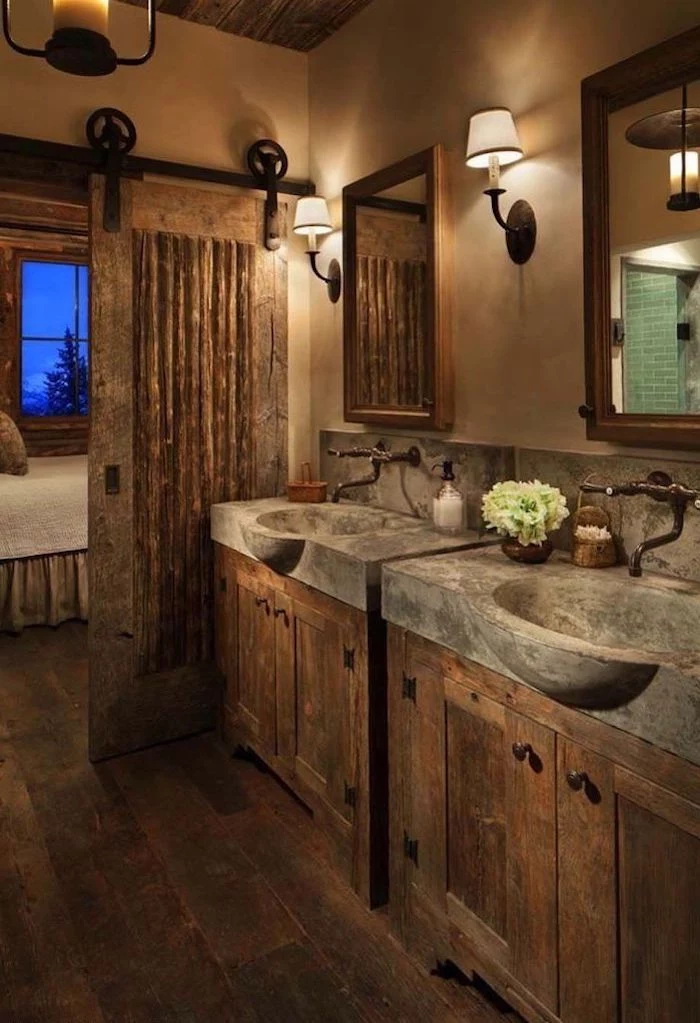
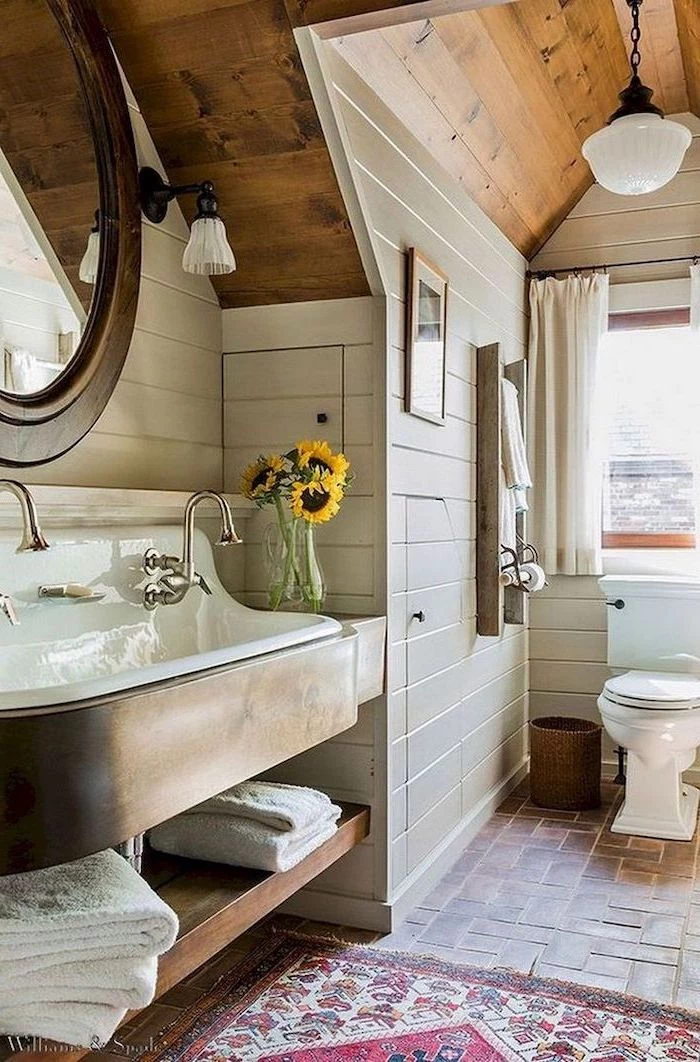
Is the all-white shiplap look over?
Not at all, it’s just evolving. The ‘Modern Farmhouse’ trend is moving towards more sophisticated applications. Think shiplap painted a moody, dark color like Benjamin Moore’s ‘Hale Navy’ for a dramatic backdrop, or installed vertically to make ceilings feel higher. The key is using it as an architectural texture, not just a default wall covering.
The single most important thing you can’t see: a quality waterproofing membrane. Behind your beautiful tile, there should be a system like Schluter-KERDI or RedGard applied to the wallboards. This seamless, waterproof layer is what actually stops water from reaching the studs and causing thousands in rot damage. Tile and grout are not inherently waterproof; the membrane behind them is what truly protects your home.

